|
|
Post by codystarbuck on Sept 23, 2021 12:10:17 GMT -5
After a bit of research, I'm now wondering if what Mike saw was some sort of planned variant of the Mk. 1 Underwater Defense Gun: the US Navy's predecessor to the H&K P11. It was introduced in the early 1970s, but was never popular and phased out in 1976 in favour of the P11. It hits most of the features of Sable's gun. It is a double action only pepper-box weapon, and its removable cylinder magazine fits into the side of a gun, being inserted and removed through a door on the left side of the gun. It fires the Mark 59, a stainless steel cylinder containing a single 4.25 inch long heavy tungsten dart. The self-contained design of the Mark 59 contributes to the propellant gases being kept in the cartridge, which eliminates muzzle blast that could produce a dangerous shock wave. It also has the side effect of eliminating muzzle flash and reducing sound. Here are a couple of photos showing the design is not a million miles away from what Mike draws. Unfortunately, I couldn't find a photo shown the gun muzzle to see the full pepper box configuration.   I saw mention of that, in relation to the P-11, but no pictures. The mechanics are pretty similar to what Grell draws, if not the frame. That was likely derived from the idea at the center of the Gyrojet, the "rocket gun" in You Only Live Twice, which was an actual weapon, tested by the Navy. The problem with the Gyrojet, as detailed in Jane's Defense (small arms reference) was that the projectile had to build up kinetic energy, in flight, to penetrate anything. In testing, they found that a couple of sheets of cardboard, pressed against the barrel, was enough to stop the projectile from leaving the barrel, since it couldn't expel enough thrust, at ignition. Lot of weapons have been designed for military contracts but never adopted, for reasons other than individual performance of the weapon. During the 9mm trials to replace the Army Colt M1911A1, the Swiss Sig Sauer P226 performed better than the Beretta 92F, which was ultimately chosen; but, the Beretta was cheaper. The F-20 Tigershark, built by Northrop, was less expensive, had better flight and dogfighting characteristics and easier to fly than the McDonnell-Douglas F-18 Hornet. However, Northrop couldn't sell it to the military, as McDonnell-Douglas had too much political clout at the Department of Defense, even with Chuck Yeager's endorsement of the aircraft. They tried to sell it internationally, but governments weren't interested in a plane that the US DOD turned down, despite being a cheaper and more effective alternative. It was derived from Northrop's extremely successful F-5E Tiger II, but that didn't matter, in the very political world of arms sales. It also explains why flying death traps like the V-22 Osprey tiltrotor continue to operate, despite and abysmal track record and numerous deaths in crashes. It was so bad there was a scandal about maintenance records being falsified to indicate better performance. It doesn't have much of a heavy lift capability and its airspeed isn't that impressive, but the Reagan Administration wanted something new and sexy, instead of upgrading helicopters that did a better job. Once it was in place, the DOD wasn't going to let it fail, even if it meant falsifying records. Typical groupthink and part of why I never made a career of the Navy. I wouldn't be surprised if Grell saw it in a gun magazine; but, if it didn't sell, that would be the end of it, as cost would probably limit commercial possibilities. Magazines like Guns & Ammo did features on all kinds of custom jobs, from companies that didn't last long. The Bren 10 was the new sexy gun, in the mid-late 80s, and was used by Crockett, on Miami Vice. However, the real weapon wasn't particularly lauded and sales weren't spectacular, and ammo was hard to find and expensive. A few 10mm pistols were manufactured, with the idea of having more punch than a 9mm, but still be lighter than a .45 (which is 11mm). Smith & Wesson then came out with their .41 cal, which was of similar size, but better ballistics and sold a few top manufacturers, like Glock, on it and guns were produced, though sales never matched those of 9mm pistols. Gyrojet was the same, in the 60s, until testing revealed the glaring flaw in the weapon (that and accuracy of the projectile). Even big names have trouble selling good weapons. Eugene Stoner, the designer of the M-16, tried marketing an integrated weapon system to the US Military, during the Vietnam era, which could be configured as an assault rifle, or support weapon (like the M-60 or M249 SAW) and it was rugged as hell and provided a weapon that required less training, since parts were interchangeable and the handling was the same. Only the Navy SEALs adopted it, but they loved it for jungle patrols, as it gave them more firepower in a less cumbersome package than an M-60. If you have ever seen the Vietnam episode of Quantum leap, when Sam leaps into a member of his brother's SEAL platoon, Sam is carrying the Stoner. The experiences with it ultimately influenced the military in purchasing the Belgian Minimi M249 as the Squad Automatic Weapon. Like the Stoner, it could fire from a belt feed or a magazine and was chambered for the same .223 cal as the M-16 (which the US forced onto the rest of NATO). |
|
|
|
Post by foxley on Sept 23, 2021 20:50:56 GMT -5
I saw mention of that, in relation to the P-11, but no pictures. The mechanics are pretty similar to what Grell draws, if not the frame. That was likely derived from the idea at the center of the Gyrojet, the "rocket gun" in You Only Live Twice, which was an actual weapon, tested by the Navy. The problem with the Gyrojet, as detailed in Jane's Defense (small arms reference) was that the projectile had to build up kinetic energy, in flight, to penetrate anything. In testing, they found that a couple of sheets of cardboard, pressed against the barrel, was enough to stop the projectile from leaving the barrel, since it couldn't expel enough thrust, at ignition. Lot of weapons have been designed for military contracts but never adopted, for reasons other than individual performance of the weapon. During the 9mm trials to replace the Army Colt M1911A1, the Swiss Sig Sauer P226 performed better than the Beretta 92F, which was ultimately chosen; but, the Beretta was cheaper. The F-20 Tigershark, built by Northrop, was less expensive, had better flight and dogfighting characteristics and easier to fly than the McDonnell-Douglas F-18 Hornet. However, Northrop couldn't sell it to the military, as McDonnell-Douglas had too much political clout at the Department of Defense, even with Chuck Yeager's endorsement of the aircraft. They tried to sell it internationally, but governments weren't interested in a plane that the US DOD turned down, despite being a cheaper and more effective alternative. It was derived from Northrop's extremely successful F-5E Tiger II, but that didn't matter, in the very political world of arms sales. It also explains why flying death traps like the V-22 Osprey tiltrotor continue to operate, despite and abysmal track record and numerous deaths in crashes. It was so bad there was a scandal about maintenance records being falsified to indicate better performance. It doesn't have much of a heavy lift capability and its airspeed isn't that impressive, but the Reagan Administration wanted something new and sexy, instead of upgrading helicopters that did a better job. Once it was in place, the DOD wasn't going to let it fail, even if it meant falsifying records. Typical groupthink and part of why I never made a career of the Navy. I wouldn't be surprised if Grell saw it in a gun magazine; but, if it didn't sell, that would be the end of it, as cost would probably limit commercial possibilities. Magazines like Guns & Ammo did features on all kinds of custom jobs, from companies that didn't last long. The Bren 10 was the new sexy gun, in the mid-late 80s, and was used by Crockett, on Miami Vice. However, the real weapon wasn't particularly lauded and sales weren't spectacular, and ammo was hard to find and expensive. A few 10mm pistols were manufactured, with the idea of having more punch than a 9mm, but still be lighter than a .45 (which is 11mm). Smith & Wesson then came out with their .41 cal, which was of similar size, but better ballistics and sold a few top manufacturers, like Glock, on it and guns were produced, though sales never matched those of 9mm pistols. Gyrojet was the same, in the 60s, until testing revealed the glaring flaw in the weapon (that and accuracy of the projectile). Even big names have trouble selling good weapons. Eugene Stoner, the designer of the M-16, tried marketing an integrated weapon system to the US Military, during the Vietnam era, which could be configured as an assault rifle, or support weapon (like the M-60 or M249 SAW) and it was rugged as hell and provided a weapon that required less training, since parts were interchangeable and the handling was the same. Only the Navy SEALs adopted it, but they loved it for jungle patrols, as it gave them more firepower in a less cumbersome package than an M-60. If you have ever seen the Vietnam episode of Quantum leap, when Sam leaps into a member of his brother's SEAL platoon, Sam is carrying the Stoner. The experiences with it ultimately influenced the military in purchasing the Belgian Minimi M249 as the Squad Automatic Weapon. Like the Stoner, it could fire from a belt feed or a magazine and was chambered for the same .223 cal as the M-16 (which the US forced onto the rest of NATO). You're probably right about the case being based on the gyrojet. From the info I was able to uncover, the US Navy initially developed a pistol called the LanceJet based on the gyrojet pistol when looking for a pistol capable of firing underwater. However, the rocket-powered weapon proved to be expensive and inaccurate (just like the gyrojet). The Naval Surface Weapons Center White Oak Laboratory then came up with the Mk1 as an alternative. So it seems likely that the designers would have been working with the gyrojet and would have been familiar with it. |
|
|
|
Post by codystarbuck on Sept 24, 2021 11:15:23 GMT -5
There was also a lot of research in the 60s and early 70s into steel dart projectiles, as used in these weapons, including with line weapons. Armor piercing capabilities were the main focus. Some of that got worked into tank rounds, but not much in small arms. During this time period, there was a lot of research going on into "caseless" ammunition, where the projectile was embedded in a block of propellant and fired, with no ejected cartridge casing. Weapons were produced, like the Heckler & Koch G-11; but, no military adopted such an idea for their infantry. Thing looked like something out of Star Wars....  I liked the fact that Grell, even when things seemed a bit unlikely, had enough real world grounding in the tech to make it work, in the story, without it being too far into superhero territory. He never went full-on Bond, with gadgets, but peppered in a few prototypes and had them work better than actual testing. The old Jonny Quest cartoon was similar, as most of the technology was being researched and somewhat plausible, if not exactly as shown. Well, aside from robot spiders (like that one), para-power ray guns, and invisible energy monsters. Gotta have some fun! |
|
|
|
Post by codystarbuck on Sept 28, 2021 0:05:46 GMT -5
Jon Sable #17 I think that is supposed to be a cestus on that hand and arm; the reinforced (and often weaponized) gloves of pankrationists, in the ancient Olympics, and Roman gladiators. The character sumbols represent the events of the Modern Pentathlon, Jon's former sport. The Mauser represents over-compensation.  Indicia Gag: Indicia Gag: (after listing subscription rates) Venusian rate: $450,000.00 (Only 15 intergalactic credits!) Creative Team: Mike Grell-story & art, Ken Bruzenak-letters, Janice Cohen-colors, Mike Gold-editor Letters page features reaction to the MIA storyline. Mike Grell starts out by telling people how they can help the crusade for an accounting of the 2500 MIA, via support letters to families (contact VFW and American Legion offices) and letters to the Vietnam delegation to the UN. Then, the first letter points out that Sable's mission constitutes a foreign invasion of sovereign soil (didn't quite describe it like that) and the shooting of Vietnamese soldiers constituted murder. No direct response to it. Others feature a 17 year old who calls them "True Americans", while identifying that they are only 17 and rather naive in some of they way they said things. A similar one equates the MIA situation to the Iran Hostage Crisis, which is a stretch. The government tried everything it could, short of all-out war, to get them out, with minimal loss of life. There was a rescue mission; it was a fiasco that revealed the US military was not up to the challenge, either logistically (which, given our military might, was shameful) or strategically. The debacle led to a lot of soul searching within the DOD, leading to Special Operations Command, centralizing Special Operations missions and units, training specifically for these types of missions. Suffice to say, I was that naive, when I was 17 (well, maybe 15-16, since I started NROTC, at 17) and did similar "armchair generaling", before I actually started to experience what real military missions and operations were like and met some of the people who train for such things. Too much Hollywood and overly dramatic "memoirs" (many of which were called out for BS, by other vets) and not enough asking questions of people with experience and hard research. Anyway... Synopsis: We pick up with the aftermath of last issue, where Jon turned 7X over to Coca-Cola and he and Maggie each pocketed $150,000 (rather than $3.5 million, or more). He and Maggie apepar to have had one last roll in the hay and then Maggie sneaks off, taking Jon's Wyeth painting, in lieu of the $25 million he cost her.... 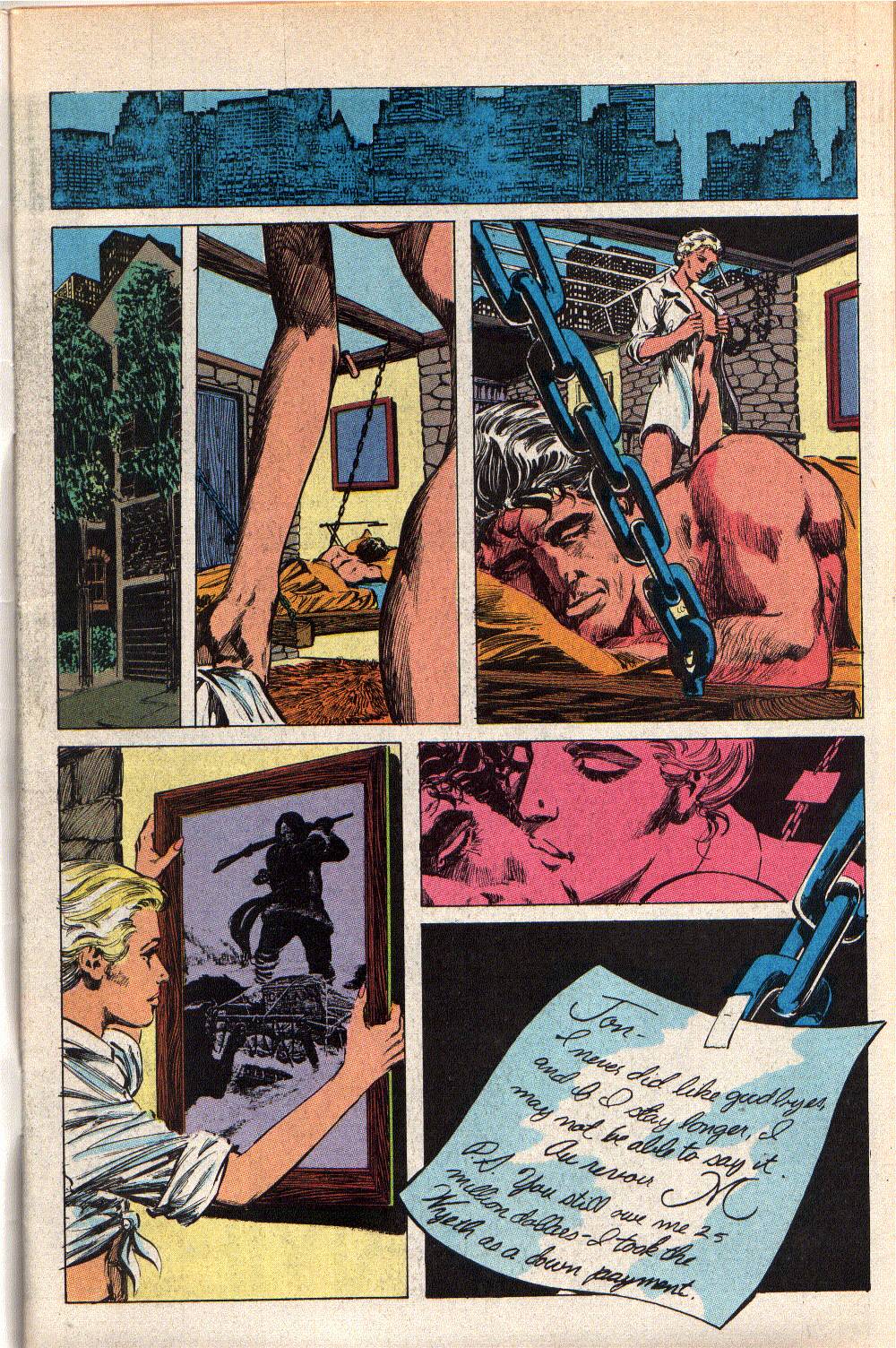 Meanwhile, Misha Yurkovich visits Grey Adler, at a rehearsal, carrying a teddy bear, a gift for Anastasia. It's a surprise for her birthday. Grey says he will keep it at the loft and Mischa can get it later. Mischa returns home and is shot dead! Meanwhile, BB Flemm visits his agent, Eden Kendall, with the latest chapter of his book and much playful banter ensues... 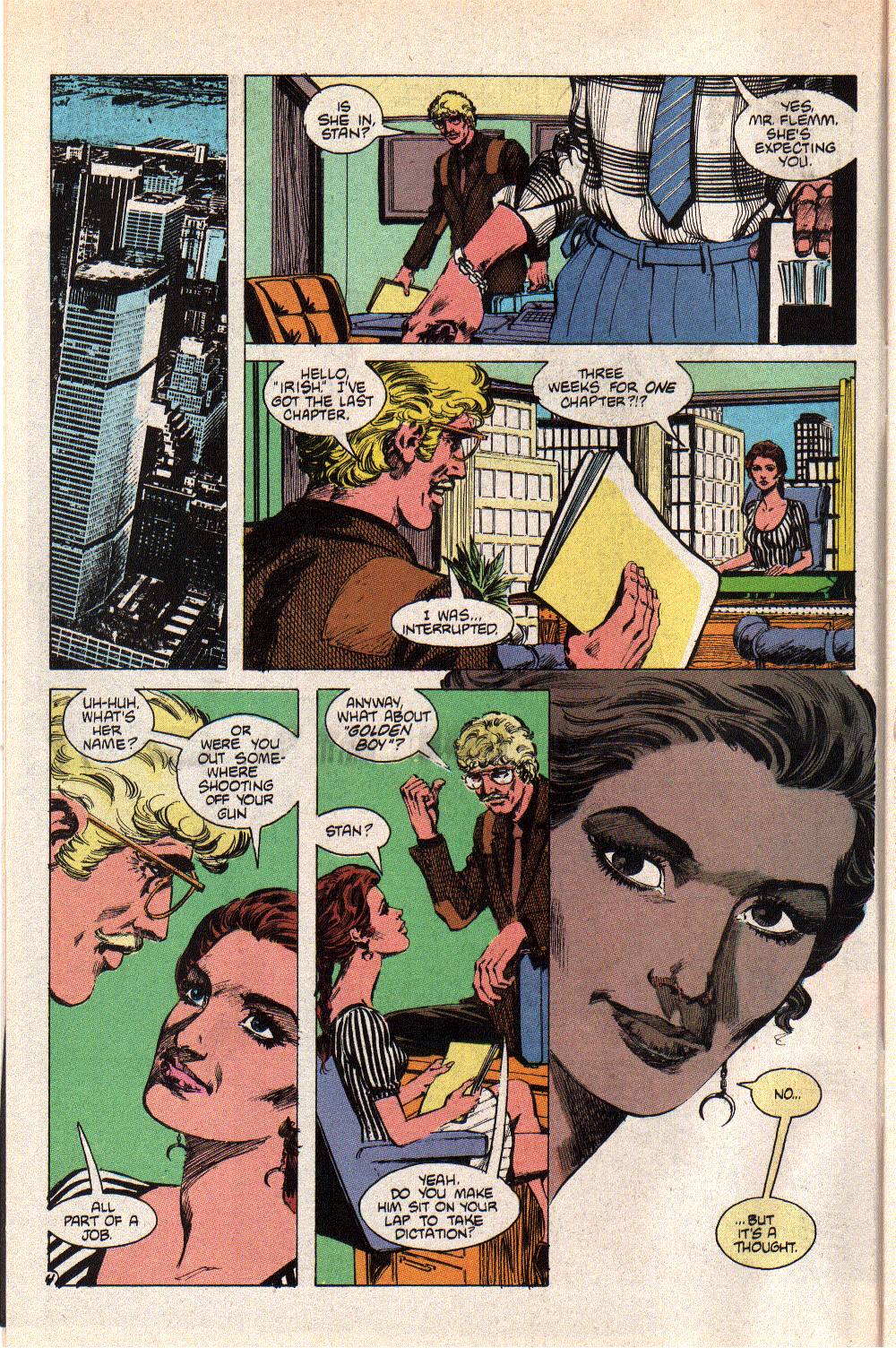 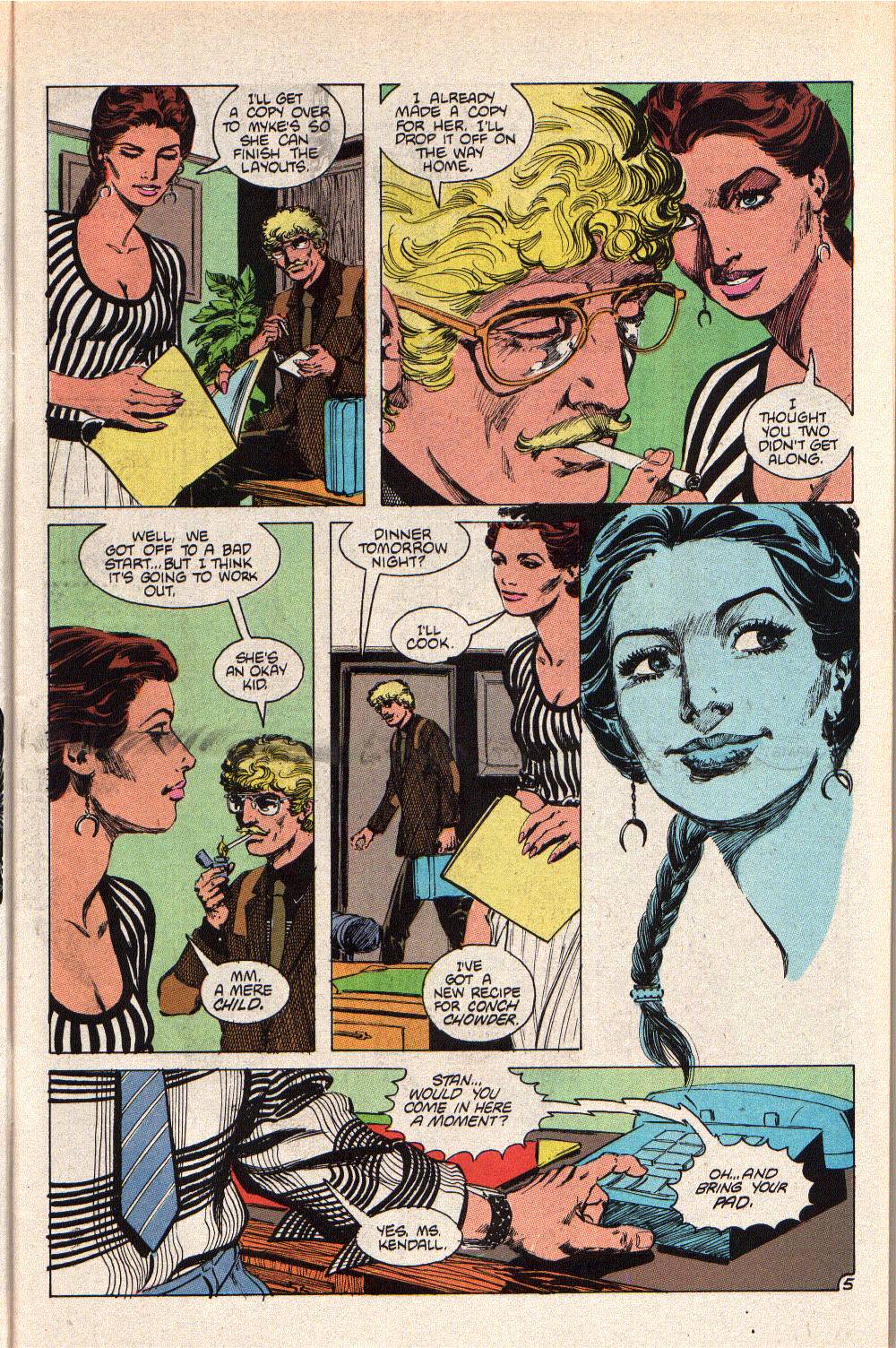 Sable offers to deliver the chapter to Myke and Eden teases him about their previous animosity. they make a date for dinner and Eden says she will try out a recipe for conch chowder (more below). Jon goes home, dumps the Flemm threads and goes to Myke & Grey's loft. Myke is finishing up a painting of a mountain lion on a snowy slope and Jon gushes over it and offers to buy it, when it is finished. myke declines, but says if he likes it, he can have it. Jon is speechless. he offers dinner, as payment and Myke laughs him off, saying a gift has no price, but nice try. They are interrupted by a very emotionally downcast Grey, who shows them the newspaper headline and tells them that Mischa is dead. At the funeral, Grey gives Anastasia the teddy bear that he was holding, for Mischa, while Harold slips Jon the police report: Two shots through the eyes, with a .22 cal pistol, the mark of a professional. Jon believes it is the KGB and Harold confirms the likelihood, given the profile of Mischa's defection, not to mention the escape of Anasasia, recently. Jon notices someone get into a car and follow, as Anastasia leaves and slips Harold his payment and ponders if the KGB wanted to set two examples, and not just one. Jon follows in his Studebaker and sees the man go into Anastasia's front door, just after she had entered. He jumps out with his Mauser, kicks in the door and yells for Anastasia, but gets clubbed from behind. When he comes to, he finds the bear's head partially torn from the body and stuffing pulled out. Jon ends up sitting in Josh Winters' office, answering questions, but he can't add much, given the man had average height and build, but then he got clobbered. he spars with Winters, since he was the one who called in the cops, and is interrupted by an outsider, and a higher priced suit than a cop's salary affords. He asks about East Berlin and Sable pegs him as CIA. The spook explains that there have been 3 other assassinations fo former defectors, all with .22 cal pistols, all shot through both eyes. The MO fits a KGB assassin, code-named "Sparrow." Jon snarls about finding Anastasia and she walks into the room. She heard the door unlocking and Sable's interruption gave her time to flee the house. The Company man wants to put her in witness protection and she refuses, since she defected for freedom, not to hide. They try to compromise, to temporarily keep a low profile, until they can flush Sparrow out and catch or kill him. She has little confidence in the CIA (me, neither). Jon offers to protect her, as a compromise, which drives Winters through the roof and the spook to deny any responsibility for her safety (typical). Anastasia trusts Sable, after Berlin and agrees. Winters tells him he hopes Jon is as good as he thinks. Winters and the Agency man confer and he asks Winters about Sable, which surprises him, given that Sable operates globally. The spy says their records are "sketchy" (wonder why? Remember issue #1?) They put a tail on Sable and he spots him immediately and Fs with him, while he tries to look casual (um, professionals work in teams). The dance troupe is performing in Los Angeles and they board an Amtrak for the cross-country trip, since the troupe has to transport everything from the company to the sets. Sable has packed his own gear.... 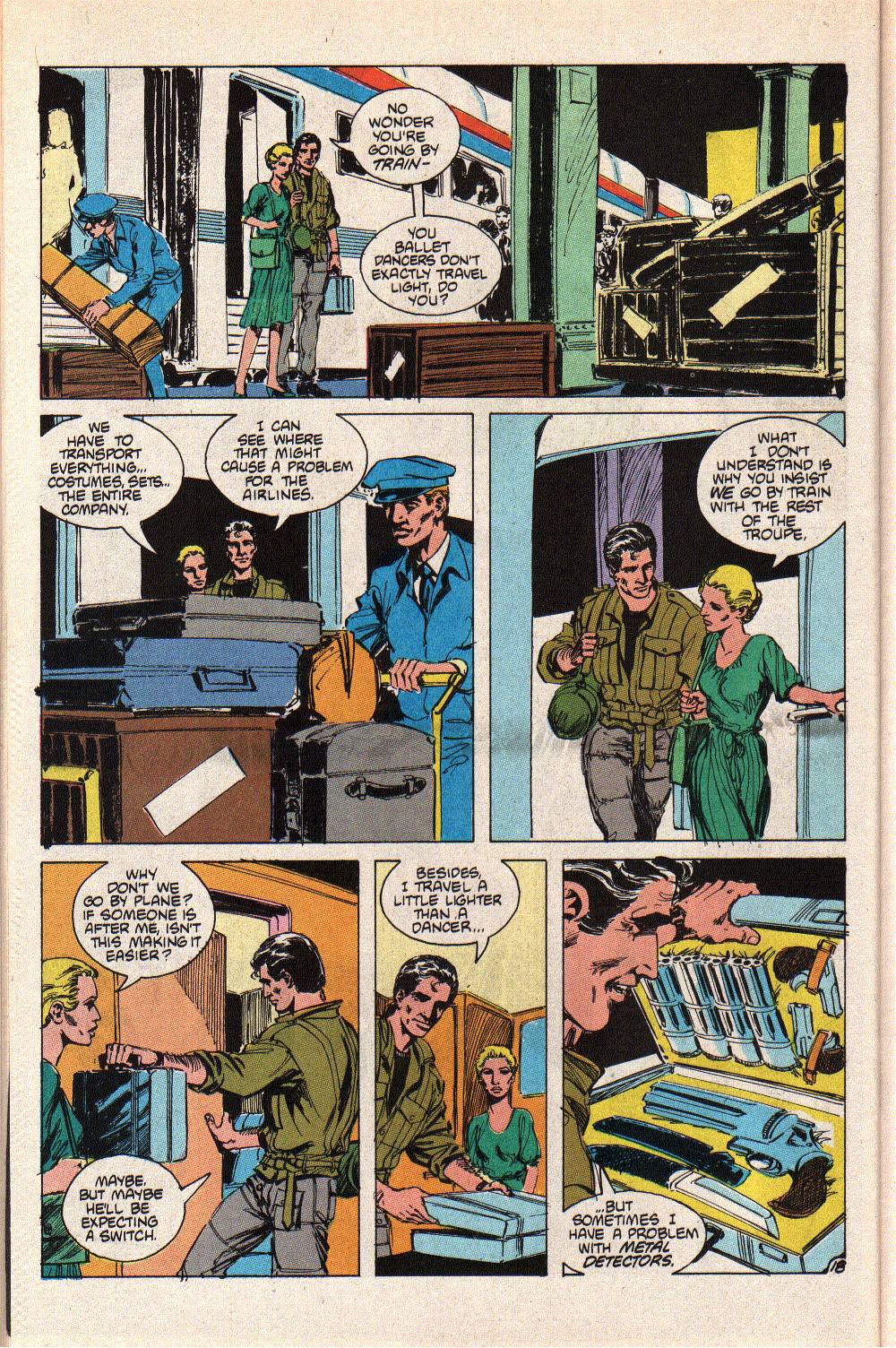 Forgot your razor, Jon. Jon checks over Anastasia's compartment and she hits him with blunt questions, prompting blunt answers. Sparrow is being hunted and probably on a clock. The longer his mission goes, the greater the likelihood of discovery. He will try again, and soon. Jon gives Anastasia the teddy bear and she tells him Mischa gave her one just like it, when they started dating. It is named Mischa (Misha, actually), the mascot of the 1980 Summer Olympics, in Moscow (which the US and several allies boycotted, over the Soviet invasion of Afghanistan). She looks at the tear and jon says the killer must have been searching for something and asks if Mischa might have been involved in anything, which Anastasia angrily denies, saying Mischa cared about dance, not politics. Jon later brings Anastasia breakfast, and is met by the sight of her, with a Walther PPK. She says Mischa thought she should have it, for protection. Jon points out that the safety is still on. he says they will soon pull into Chicago, where there will be a layover. they will use that to disappear from the train. The couple depart the train, in Chicago, disguised as a pair of New Wavers. They see the sights and we get a travelogue of Chicago, minus the Cubs... 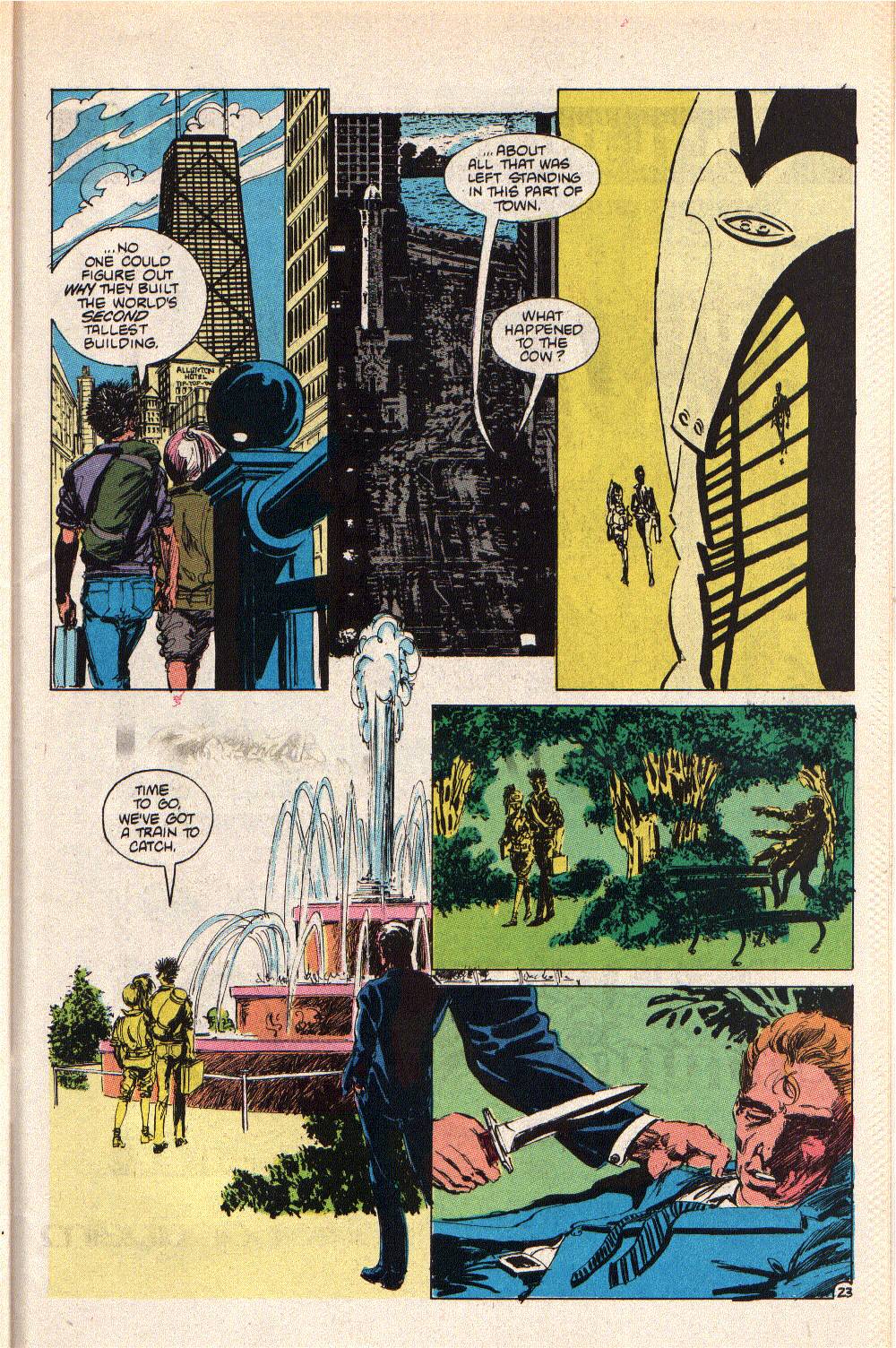 Given they are in Chicago, the guy getting knifed may or may not be related to them. Could have just been an enemy of an alderman! Or a White sox fan! They return to the station, but board a different train, which will go through Montana, before heading to California. Anastasia grows tired of hiding in a compartment and Jon relents and they eat in the dining car. he spots someone and the casually leave and he tells Anastasia to lock herself into her compartment and to kill anyone who tries to get in. He then intercepts a shadowy figure and threatens to stick his boot dagger into the man's ear unless he can give him a good reason, within 3 seconds. The man says he is CIA and shows his credentials. Jon relaxes and the man says his partner was killed in Chicago. Then, he says something else, with a .22 cal target pistol... 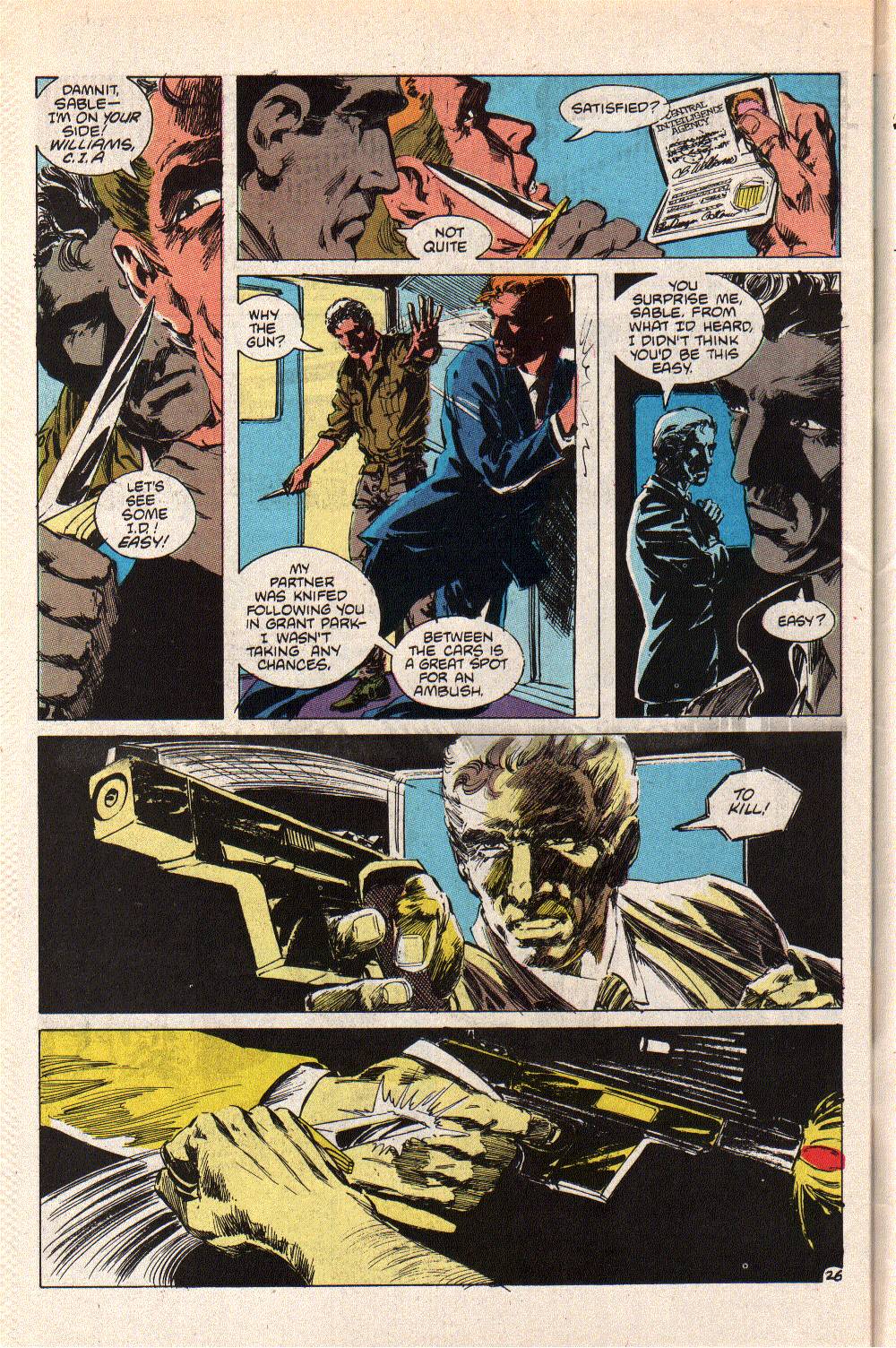 It is Sparrow! Jon knocks his gun hand away just in time and they have a brutal fight (Fleming would be proud!) and then Sparrow brings a knife to a gun fight and Jon rumps him with his Mauser. However, Sparrow's knife is KGB (and SPETSNAZ, according to my research) issue: a ballistic knife.... 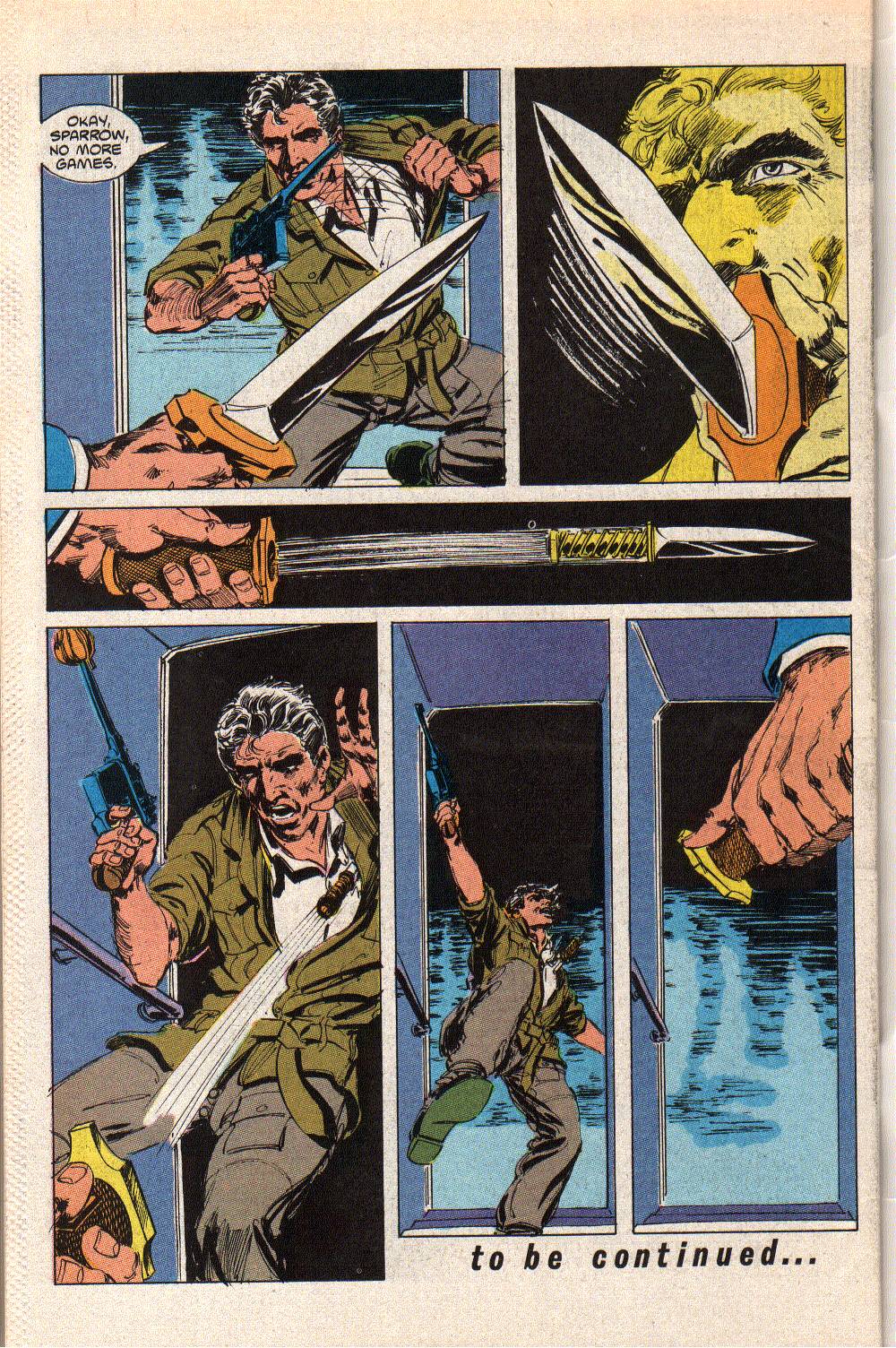 Thoughts: Thoughts: Well, now we are in real hybrid territory, as this is a mixture of a standard detective/cop plot of protecting a witness from a hitman and a spy thriller, with an enemy agent stalking a defector. Obviously, the KGB think that Mischa had something of interest, possibly hidden in the bear; but, as Anastasia said, Mischa cared only about dance, not politics or treason. So, why would the KGB think that? Despite spy thriller plots, the KGB doesn't generally send assassins after defectors, unless they are someone like Leon Trotsky, who is a political revival to someone like a Stalin. Dancers are not targets and they are always training new dancers. There is more than meets the eye here. I don't know anything about the logistics of transporting a dance troupe, across country; but, the cost of such a thing would more likely be spread out with a cross-country tour, rather than travel solely to the coast. Even by train, that's a heck of a bill, for one city. More than likely, they would commission sets locally and bring costumes and props by air, along with the dancers. However, it makes for a great setting for intrigue and is likely inspired by Ian Fleming's From Russia With Love. The film version pretty closely follows the book (though exchanging SPECTRE for SMERSH) and both feature a journey on the Orient Express, with Tatiana Romanova, a cypher clerk from the Istanbul Embassy, and a stolen Lektor coding machine. They are hunted by a SMERSH (SPECTRE) assassin, Red Grant, a British defector and killer (played wonderfully by Robert Shaw). His role reaches its climax in a brutal fight on the train, with Bond and the film 's stunt team did an amazing job with it. That pretty much provides the template, here. You could also add a bit of the 1976 Comedy/mystery film, Silver Streak, staring Gene Wilder and Richard Pryor (and Jill Clayburgh and Patrick McGoohan) in their first pairing. That also features murder on a train and goons looking for something being transported on the train, plus the hero falling off the train (with a lot of help, in the case of Wilder's character). Another very likely inspiration is Hitchcock's North By Northwest, where Cary Grant is mistaken for a spy. He ends up on a train to Chicago, with a woman, named Eve Kendall and I suspect that name's similarity to Eden Kendall isn't a coincidence. With Sparrow, we move beyond poachers, mercenaries, neo-Nazis and thugs. This is a trained professional, while Jon, talented as he is, has only his experience in the bush and his own commissions. He is a survivor, a crack shot and a trained athlete, in a military-style competition; but, he is not a trained killer, with years of experience in tradecraft. Can the talented amateur beat the seasoned pro? The ending makes it seem doubtful, though I doubt we were going to kill off the lead, after 17 issues, without a cancellation notice (especially since he is a creator-owned character). The Olympic motif is deliberate, as 1984 was the year of the Los Angeles Summer Olympics (and the Winter Olympics, in Sarajevo, back when they occurred in the same year). The Soviet block boycotted the games, with the exceptions of Romania (which was a Warsaw Pact member), Yugoslavia (which was not and had remained relatively independent of Moscow) and the People's republic of China (who were at odds with the USSR). There was much fear, given the Iran Hostage crisis, the Marine Barracks Bombing, in Beirut, and the alleged Libyan Death Squads, that the games might be the scene of another terrorist attack, as in Munich, in 1972 (which Jon witnessed, in this world). The FBI and other security and DOD agencies worked together to prevent a possible attack, including SEAL Team 6 (which doesn't really exist; it's called DEVGRU, which stands Naval Special Warfare Development Group), then led by LCDR Richard Marcinko, which would later factor into the investigation of him for, among other possible crimes, misappropriation of funds, related to security of the Olympics, in the purchase of stun grenades, at a high price, as detailed in his memoir, Rogue Warrior (which, the general consensus in the Navy was that his claims of a witch hunt were probably true, though some of what he said in the book cried BS). So, setting a spy thriller in the midst of the Los Angeles Olympics (assuming they even get there, and I would, given the cover), would seem to be a no-brainer. Ironically, the Atlanta Olympics, in 1996, was the seen of domestic terror, but the better coordination of security agencies under the Clinton Administration successfully headed off several plots, both in Atlanta and for the 1999-2000 Ne Year Millennium Celebrations, as detailed in security czar Richard Clarke's memoir, of his time from the Reagan to the George W Bush Administrations. he gave high praise to the Clinton Administration for taking terrorism seriously and challenging security agencies to think "outside the box." The use of a .22 cal target pistol is pretty consistent with actual assassination weapons. The Phoneix Project, a CIA operation in Vietnam, often used the Colt Woodsman .22 cal target pistol for sentry removal and assassination, while using a noise suppressor (aka a "silencer") to make it virtually silent, due to the lower expulsion of combustion gasses from the primer charge. A .22 is much lower velocity, than a 9mm or .45, and needs a smaller suppressor to reduce the sound of the firing of the bullet (a silencer acts like a car muffler, redirecting the emitted gases through baffles, causing them to lose energy and dampening the sound accompanying them). What Grell draws is pretty consistent with several styles of competitive target pistols, as used in the Olympics and other competitions. The ballistic knife that Sparrow uses was supposedly also carried by Russian Special Forces, especially SPETSNAZ, who were controlled by Army intelligence, the GRU. 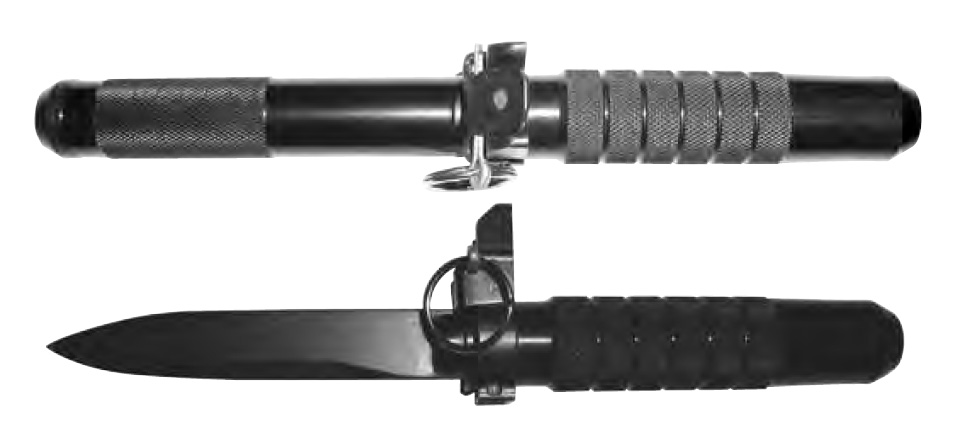 The weapon consists of a hollow hilt, that contains a powerful spring, and a dagger blade, shaped to act like a dart. The blade is locked into the hilt and a trigger releases the spring, which propels the blade at relatively great distance (about 16 ft). SPETSNAZ also used a dagger with a 7.62 mm bullet, that fired out of the hilt, similar to naval weapons that combined swords and daggers with pistols. These weapons were identified in the 1970s, in publications and were the darlings of military surplus and knife catalogs in the 80s (I ended up on those mailing lists, after buying some camo fatigue pants, via mail order, when I was in high school), which is probably where Grell came across them. His design is a bit different, though I swear I saw one like it, in a film of that era, though I can't clearly recall what film it was. Last issue, in the letters column, Mike Gold said their would be a recurring villain introduced, which is Sparrow, as we will see. Meanwhile, apart from the spy stuff and exotic weaponry, Grell continues with the dance between Jon and Myke, as well as the comedic banter between Jon and Eden, including a repeat of him calling her "Irish," after the revelation that she is actually Polish, and her real name is Edna Mae Kowalski, not Eden Kendall. Eden's reference to conch chowder is a nod to a line in the film version of Thunderball (and in the book), when Bond meets Domino. It is supposed to be an aphrodisiac and is a traditional dish at Bahamian weddings. We are left to wonder, though, if Eden actually does sexually harass her male assistant. Next up, did Jon survive? Well, yeah, obviously, but how? What is Sparrow after and how does the Olympics fit into the picture? Answers to come.
|
|
|
|
Post by foxley on Sept 28, 2021 2:14:28 GMT -5
He could shave with that tanto!  (Yesterday, I re-watched Death Rides a Horse for the first time in years. One of the running gags in the film is Lee Van Cleef's character keeps shaving with a throwing knife. At the end of the film, after he has used the knife to kill the main bad guy, John Phillip Law points out that he is out of ammo and doesn't even have his razor.) The only other comic story I can think of that prominently featured the 1984 Olympics was a 2-parter by Mike W. Barr in Batman and the Outsiders #14-15, with art by Bill Willingham in #14 and Trevor Von Eeden in #15 (And Aparo covers). (And, on a personal note, Barr/Von Eeden is a writer/artist combo I wish there had been more of.) |
|
|
|
Post by codystarbuck on Sept 28, 2021 11:29:07 GMT -5
ps Forgot to mention; I know I have seen the Wyeth painting before, but Google didn't help me locate it or the specific title and source. It looks a bit more like Andrew Wyeth's style, but, this is Grell's interpretation, so it could be NC Wyeth, as it fits the kinds of subjects he illustrated, for books and magazine stories. Anyone who can identify it, please shout out. I used to have a few books of NC Wyeth's art, but gave them up in a move. Most of them focused on the work he did for the Scribbners books (like his Treasure Island illustrations) and some of his more notable paintings and illustrations. I did not have much reference for Andrew, since NC did more of the storytelling art, which is more my interest.
|
|
|
|
Post by codystarbuck on Oct 1, 2021 0:22:15 GMT -5
Jon Sable #18 Jon doing some stretching before going hunting for Sparrow. Always warm up before strenuous exercise! Indicia Gag: repeat Creative Team: Mike Grell-Official writer & artist of the 1984 Summer Olympics, Ken Bruzenak-Official Letter of the 1984 Summer Olympics, Janice Cohen-Official Colorist of the 1984 Summer Olympics, Mike Gold-still waiting for tickets to badminton and editor. Anybody who was alive in 1984 (Well, older than about 3) will understand that joke. Letters page has more about the MIA issues, mostly supportive, but one that attacks Mike Gold's comment about Nixon reneging on a campaign promise to end the war and actually escalating it. Gold stands by his comment. Synopsis: When we left last issue, Jon took a knife in the chest and fell off the train, like Gene Wilder... (love that movie!) Sable is alive and wakes up, staring up at a moose, with a knife sticking out of his chest. He sets about making a fire and preparing to remove the knife..... 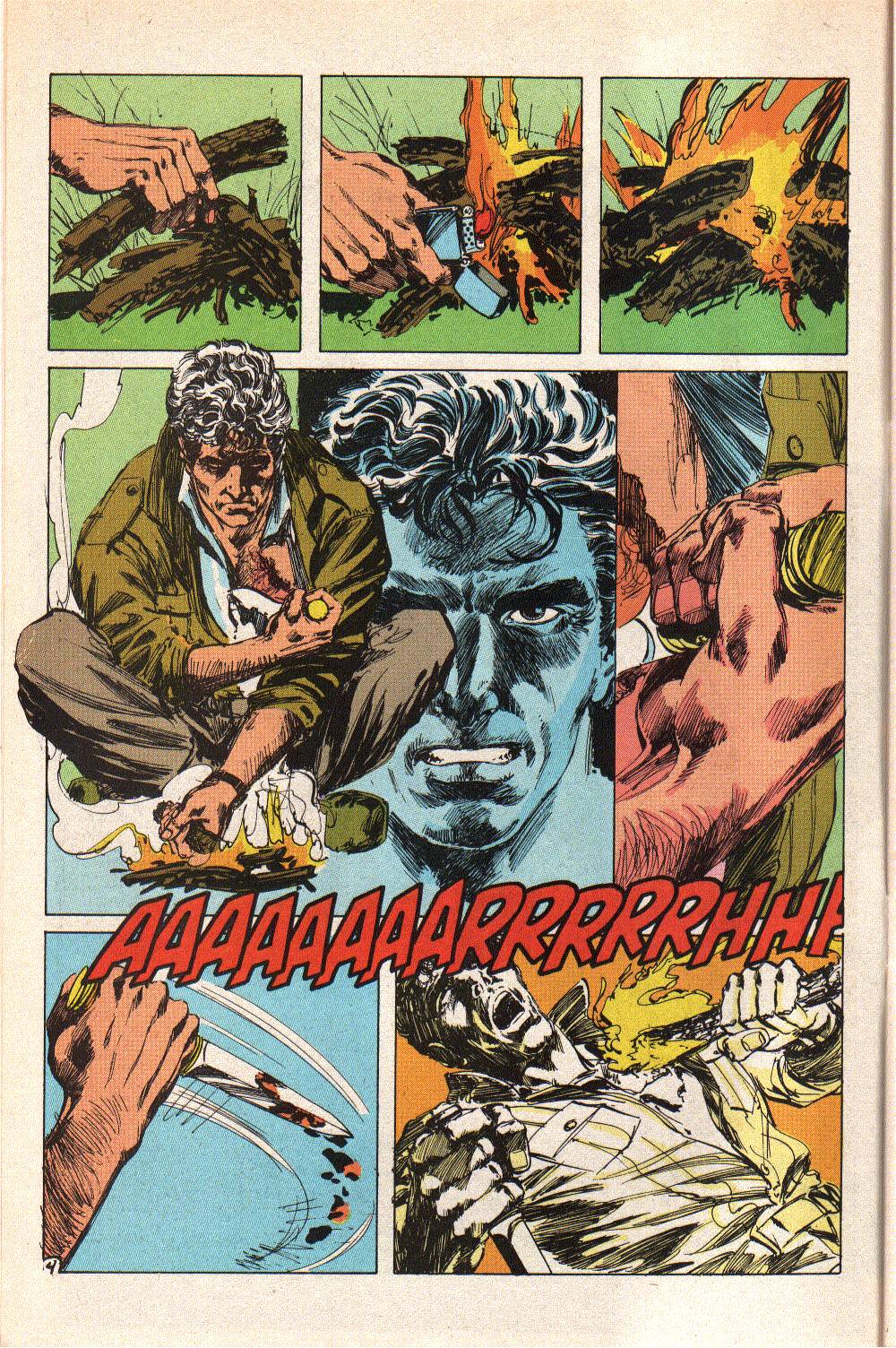 Let's see Bear Gryllis do that! Jon treks on to find civilization and washes his face in a stream, but he is feverish and collapses. He wakes up again to find that the moose around here are funny looking, and we see it is a horse mule. The mule's companion, who is sketching, is drawn by the animal's attention and finds Jon. She takes him back to her cabin, sees his wound and previous scars (from the MIA mission) and fixes him up. he wakes up to find himself in her bed, nekkid and confused... 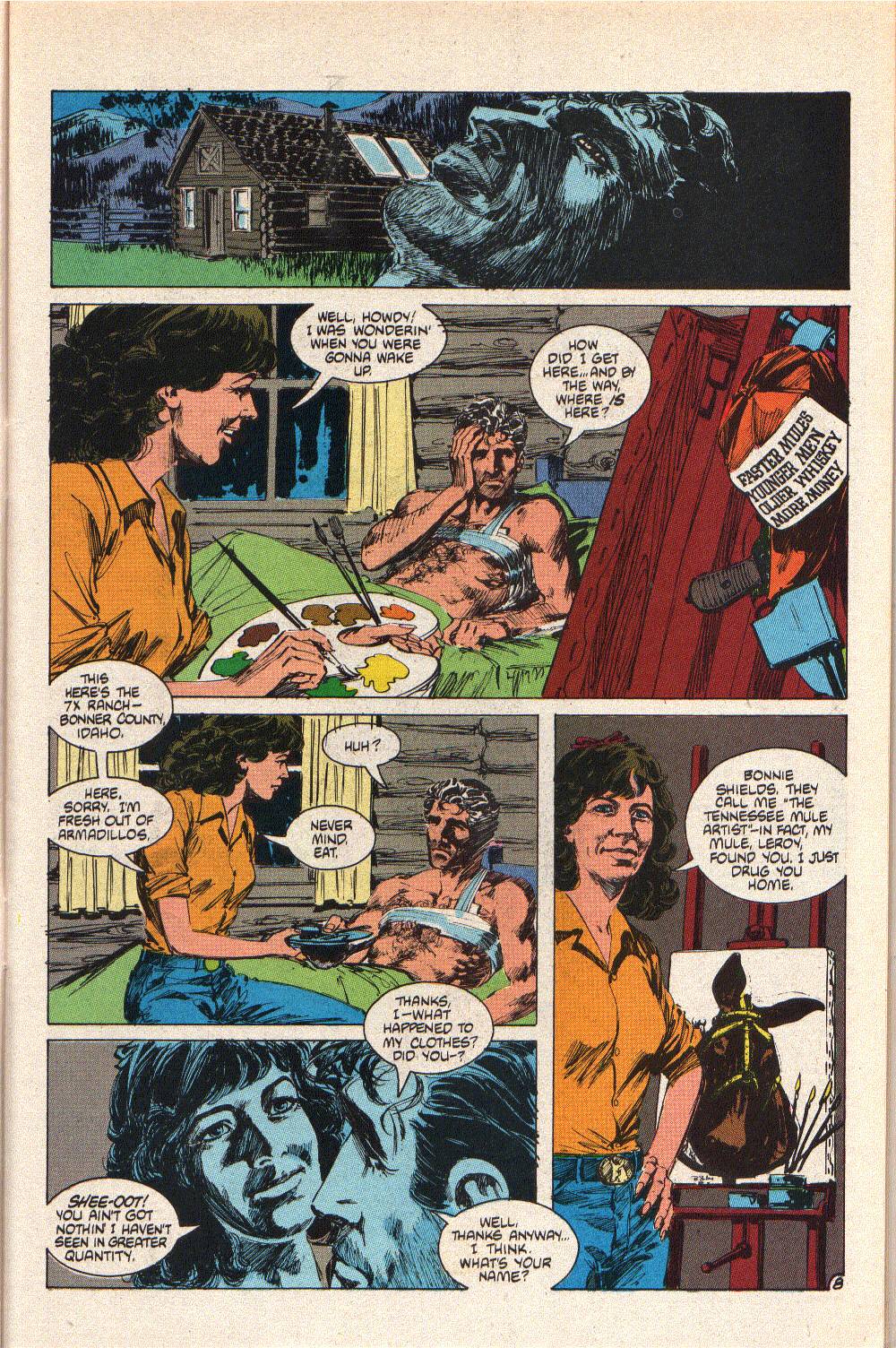 Jon is confused, as he thought he was in Idaho and he is right, as Bonnie is a transplant. She has questions of her own, starting with Jon's weaponry. He explains. He tells her about the defection in Berlin and Bonnie has read about it. He tells her the rest and says he needs to get to an airport. Bonnie says the nearest one is in Spokane, but knows someone who can help. They go to a small airstrip and Jon is introduced to a pilot, named Greg, who has heard of Sable. he remarks that he had been a sort of soldier of fortune, in his time. He gives Jon a ride in a T-6 Texan trainer aircraft, from WW2. The pilot gets Jon to LA in time to beat the train and Jon expresses his thanks and the ex-Marine tells him to call him Pappy.... 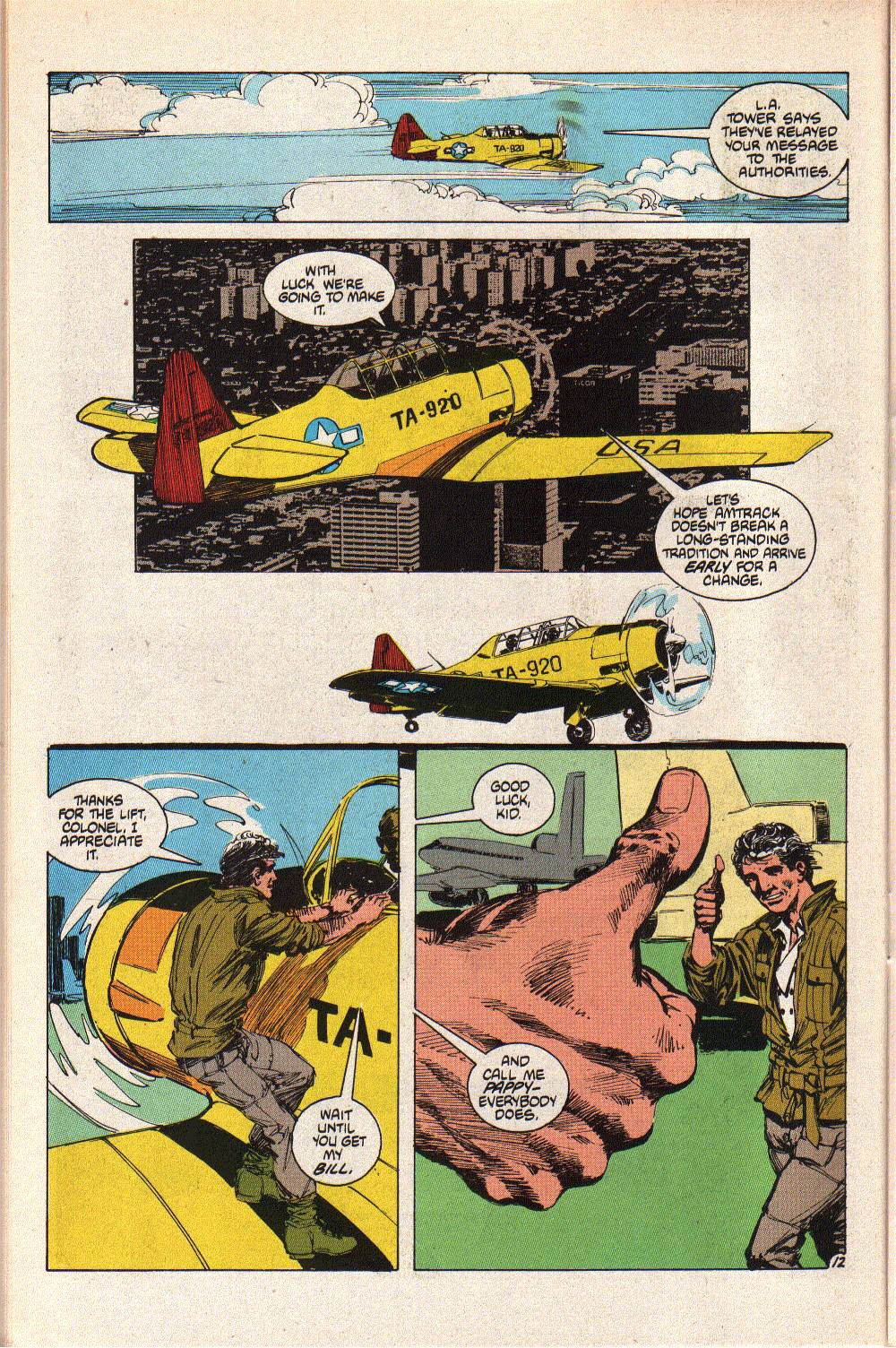 Jon goes to the LA train station and runs into the CIA agent. He says Jon's tail was killed in Chicago and when neither Sable nor Anastasia was onboard the original train, the spook flew out to investigate. His men have the inbound platform covered, as the second train arrives. They burst into the compartment and find only the teddy bear and luggage. One of the Company men finds a .22 cal cartridge casing and identifies the ammo as the type used in shooting competition, in the Olympics, He puts forward the theory that Sparrow might be SPETSNAZ, which Sable misidentifies as a terror network, rather than Soviet Special Forces. They wonder if he might be using the games as a cover to enter the country, posing as an athlete from a team that didn't boycott the Olympics. The spook says Winters was right about Sable and he should have stayed out of things. Jon goes to a bar to drown his sorrows and play "As Time Goes By", so Grell can do some Casablanca references.... 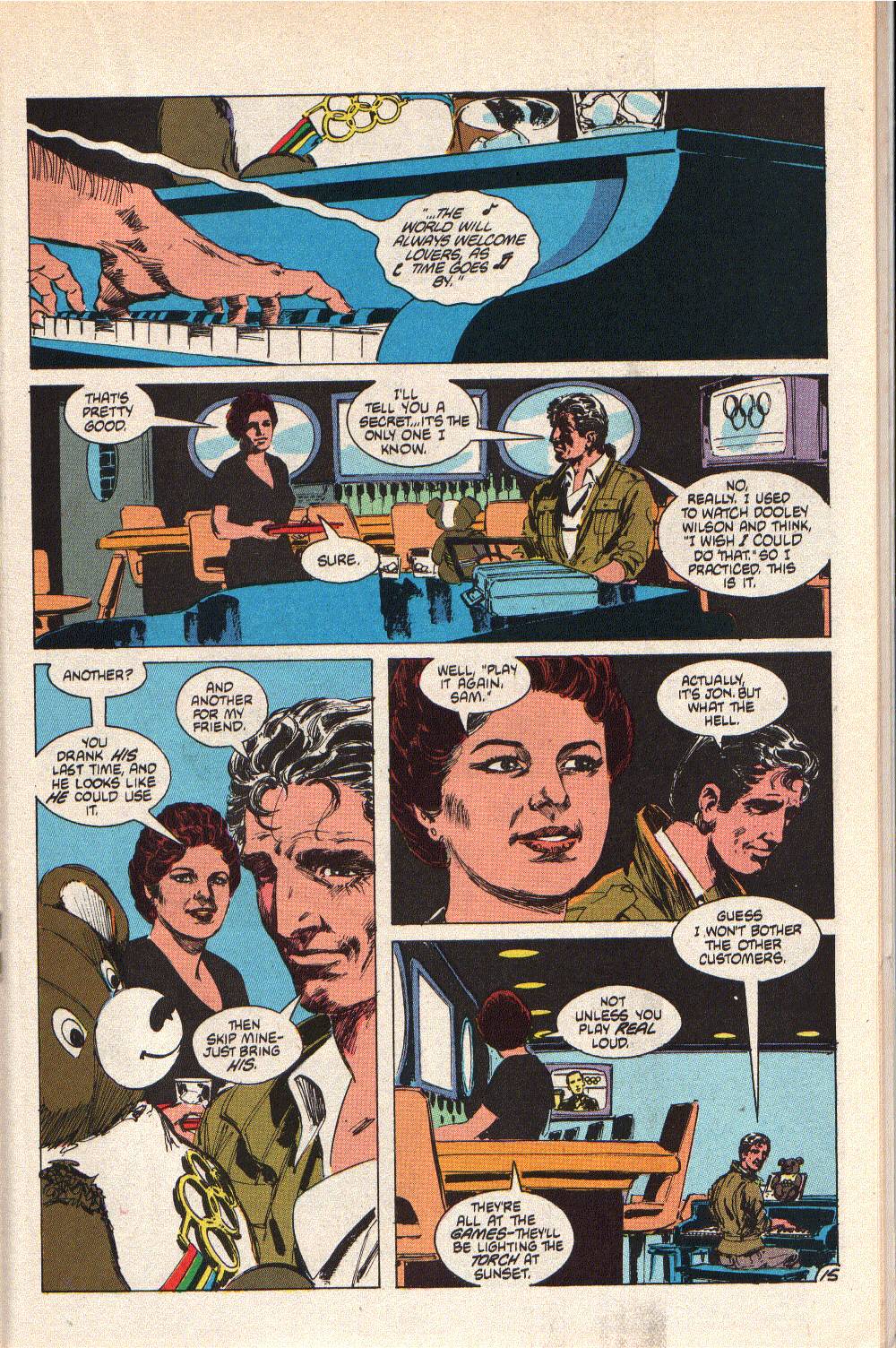 The bar is pretty well deserted, as everyone is at the games. Jon looks at the tv screen and sees the Olympic rings, then notices, for the first time, that the Olympic ring belt that is around the teddy bear is fastened upside down. He removes it and finds a small dot taped to the back of the belt, with a date written in pen: Sunset 7/28. Jon runs to the men's room and pulls out his handcannon, then calls the CIA man about the microdot. They arrange to meet. They do so, at the LA Olympic Colosseum. sable tells him they need to delay the games and the spook goes ballistic. he says they have searched and no sign of Sparrow. Jon says the note is a reference to the Torch lighting, but the CIA dude takes the microdot for analysis. Jon gets an idea and grabs a camera, with a telephoto lens and searches the area, then spots someone with a ling case. he is sure he has his man. Jon runs in, but Sparrow is waiting. However, Jon fights like a tiger and nocks away Sparrow's .22 target pistol. Sparrow has Jon's head trapped and goes to break the neck and Jon stabs his tanto knife into Sparrow's thigh, then Fs him up... 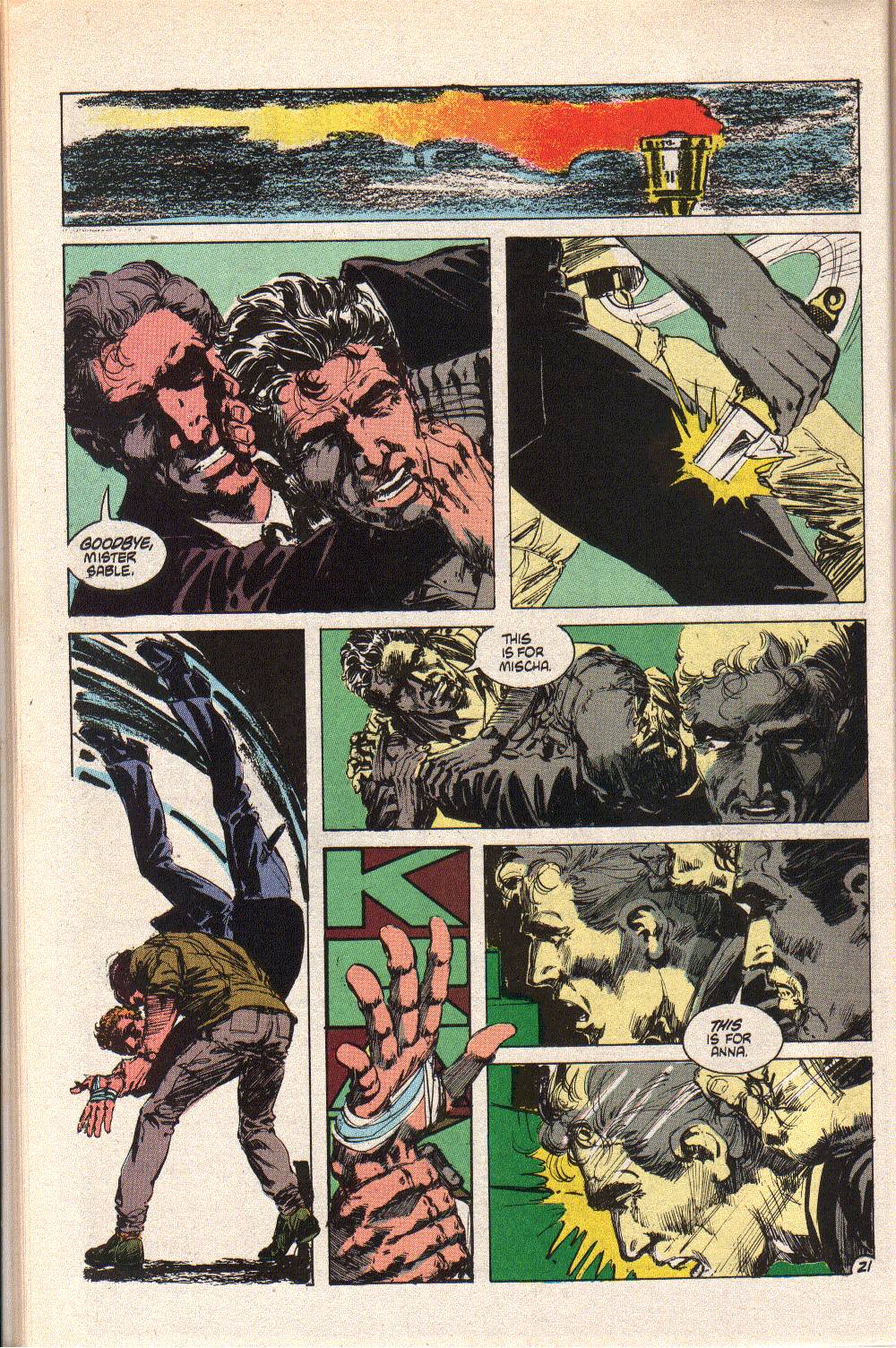 He then runs upstairs and kicks in a door and tells Anastasia hello, as he points his handcannon at her. She is holding a rocket launcher. Jon runs down the score... 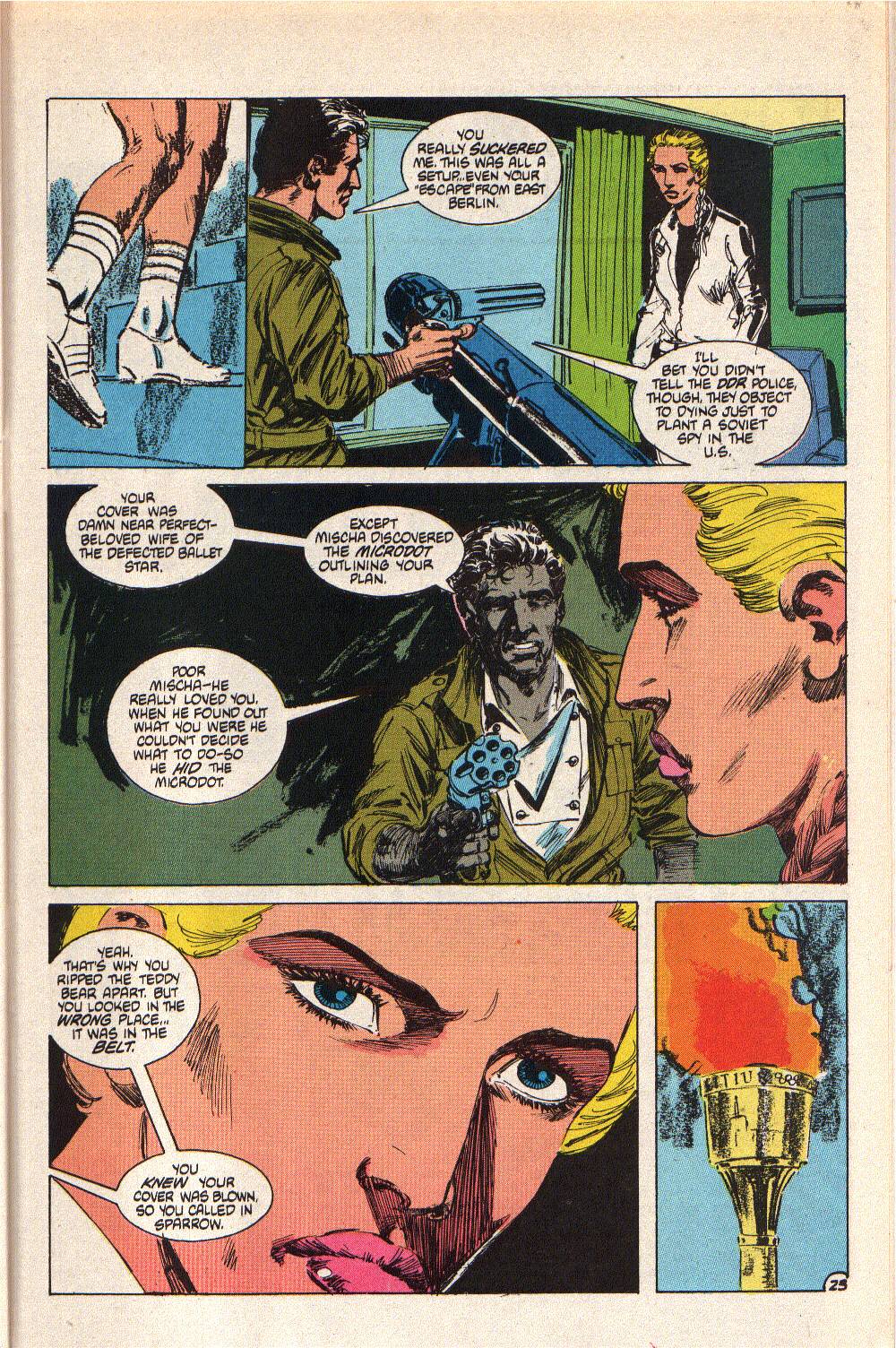 Anastasia reveals that the plot was to blow up the torch and the man who lights it (which was former Gold Medalist Rafer Johnson), to embarrass the US, for boycotting the 1980 Moscow Olympics. Ana then decks Jon with a kick and runs off, holding a transmitter. She gets into a car and Jon fires his handcannon out the window and hits the car, igniting the fuel tank. Ana presses her detonator and the rocket launcher fires its rocket, which turns out to be a heat seeker and swerves to hit her burning wreck, utterly destroying it and her. Rafer Johnson (though Grell drew this before the games and the arm of the unseen man lighting the torch is colored white) lights the Torch to signal the opening of the Olympic Games. Sable waits and the CIA guys turn up and they say theGames opened without incident. Sable points to the burning car and asks how they are going to spin that to the press. The answer is just another burning Pinto. The cart away Sparrow. Thoughts: Bang up conclusion (literally) to the Olympic two-parter. So, Anastasia was actually a KGB agent, with the ballet as her cover. Mischa learned the truth and confronted her, then was murdered. Sable figured it out, thanks to Mischa's note, left on the teddy bear. The microdot contained instructions, which is how the CIA later turn up. Nice mix of spy thriller and detective story, as I said before. The plot to disrupt the games makes sense, but the reasoning for it is a bit of a stretch. The Soviets disrupted the games by keeping the bulk of the world's top athletes, in multiple sports, away from the games, making the medals meaningless, as the Olympic champions were shown up in international competition, after the games, in many cases. However, with Romania ignoring the boycott, the top women's gymnastics team was there, though coach Beyla Karolyi (who had defected) was helping the American team, including the star of the women's gymnastics, Mary Lou Retton. The Soviets would never sanction a terrorist action, by their agents on American soil, as it would lead to reprisals, possibly war. Through cutouts (like Libyans or other terror cells), maybe, but that is a stretch. More than likely, any real threat would have come from a terrorist cell on their own; or, as was seen in Atlanta, in 1996, from a domestic terrorist. Regardless, it makes for a good reason for Ana to be traveling on a train, to transport the rocket launcher, without airport inspection or long haul by motor vehicle. The fight between Jon and Sparrow is pretty brutal and the use of the knife was obvious, given Grell made a point of showing it in Jon's gear. Grell never disobeys Chekov's gun rules. By the same token, We knew he would use the handcannon, at some point. Having Ana's escape vehicle be a Pinto, is another subtle joke, though you had to be alive in the 80s to understand that. There had been several fires related to rear-end collisions with Ford Pintos, due to the placement of the gas tank. SNL and numerous comics (people like Johnny Carson and various stand-up comics) made jokes about Pinto's bursting into flame from the lightest touch. We get a couple of real life cameos in this one. Bonnie Shields is a real artist, known for her paintings and illustrations of mules and horses, who lives in Idaho....  More about the artist here. More about the artist here.I assume Mike is a fan and probably met Shields. I know he was in Wisconsin, when he started the series, but, if memory serves, he relocated to Idaho or Washington, at some point, in the 80s. i know that was part of the reason for setting Green Arrow in Seattle. The other cameo, aside from the T-6 Texan, is the pilot, Greg, aka Pappy, who is better known as Col. Gregory "Pappy" Boyington, Medal of Honor winner and commanding officer of VMF-214, better known as the Black Sheep Squadron. Boyington was the highest scoring ace for the Marine Corps, in WW2, credited with 26 kills (though one was only made official after he was released from a POW camp. Boyington was shot down, on January 3, 1944, during a mission over Rabaul, after his squadron and others challenged the japanese to sortie their planes, where he earned his 26th kill, but was lost in the general melee. He did not return to base and a search proved futile and he was listed as missing, believed killed. He was actually picked up in the water by a Japanese submarine and taken prisoner, but was never reported to the Red Cross and was not given POW status. He was held at Rabaul, then Truk (and was nearly killed during as US attack on Truk) and then transported to a camp near Tokyo, where he finished out the war and witnessed the fire bombing. he was released after the Japanese surrender, following Hiroshima and Nagasaki.  Boyington's remark, about doing a bit of soldier of fortune work, of a sort, relates to his service with the American Volunteer Group, better known as The Flying Tigers. Boyington resigned his commission in the Marines, in August, 1941, and joined the group, flying with them until 1942, when he broke his contract, made his own way back to the US and rejoined the Marine Corps, which was desperate for experienced pilots. The AVG (hereafter called The Flying Tigers) was technically a civilian group, though it had authority from Pres Roosevelt to recruit from the military, prior to the US entry into the war. Pilots had to resign their commissions in the US Armed Forces and then became paid employees of the Central Aircraft manufacturing Company (CAMCO), where they were designated a Special Air Unit. Technically, they were mercenary soldiers, fighting for pay, for a foreign government, earning bounties on confirmed kills. There is some popular belief that the Neutrality Acts of 1935-1939 prohibited US citizens from serving as mercenary soldiers, but that is not exactly the case, as they prohibited arms sales and lending to belligerent states, in relation to the Spanish Civil War, the Italian invasion of Ethiopia, and the outbreak in war, in Europe, until the Lend-Lease Act was passed. Citizens could not participate in acts of aggression, from the US, but there was no language about acts on foreign soil. The US was able to openly back the Chinese, since Japan never declared war on China and therefore the situation was not covered by the acts. Thus, the government could openly support the Flying Tigers. That group would provide the inspiration for Quality Comics' Blackhawks (as well as the Polish and other occupied territory aviators, who served in the RAF). Boyington was from Idaho and lived in Tacoma, WA and attended university at Univ of Washington in Seattle. He was living in Fresno, CA, at the time of his death, in 1988, but I don't know if he was still in Washington, at the time of this comic. I read his memoir (Baa Baa Black Sheep), years ago, but, it was written and published in 1958. He did make 2 appearances in the Robert Conrad tv show (one in each season) and helped promote the show, though he dismissed much of it as "Hollywood hokum," (especially after other members of the squadron publicly criticized the portrayal of the pilots as disciplinary cases and screw-ups. They had been part of a reserve pool, when Boyington got permission t form a new squadron). The segment with Jon being found by Bonnie, then flying with Greg to meet back up with the train matches part of the plot of Silver Streak, as Gene Wilder gets dropped off the train a couple of times, one of which he finds a farm and gets the help of the woman who lives there, who also flies a crop duster and gives him a lift to the town where the Silver Streak will make its next stop (after some acrobatics and buzzing of some sheep). They fly a Stearman bi-plane, though, not a T-6 Texan. The Texan is a nice choice, for Boyington, as the aircraft was used to double Japanese AIM-6 Zeroes, in the tv series (and the movie Tora! Tora! Tora!), as it had a similar silhouette (though different cockpit design). Not quite as iconic as Boyington's wartime plane; but, a Corsair isn't a two-seater! I'm not sure where Grell got his ideas about SPETSNAZ; but, I suspect it was something like BS military magazines or other amateur publications. SPETSNAZ is a general term for Soviet Special Forces and it covered a wide range of specialty troops, like the Soviet Airborne, Rangers (Visotniki) and Naval Infantry combat swimmers. Special Operation missions fell under the GRU, Soviet Military Intelligence, rather than the KGB, who had their own specialty troops. The GRU did carry out espionage activities, related to military subjects; but, the KGB handled the bulk of foreign intelligence operations. It is similar to the relationship between The CIA and the Defense Intelligence Agency or the Office of Naval Intelligence. The GRU would coordinate SPETSNAZ activities with friendly insurgent groups or missions targeting enemy military installations or organizations; but, it did not coordinate terrorist activity. That was the area of the KGB, which aided in training and equipping of terrorist groups, though usually through friendly nations, like Libya and Syria. It might provide intelligence and equipment to such groups, but it was careful about being directly involved in their operations. Much of what was known, at the time of this story, came from a Soviet defector, Victor Suvorov (real name Vladamir Bogdanovich Rezun), who had served in the organization, until his defection, in 1978. he settled in the UK and published several books, including one about SPETSNAZ, in 1987). He made all kinds of far-fetched claims about GRU training, including the supposed use of criminals as training targets, for assassination exercises. Many of his books have been called out for accuracy, especially after the collapse of the Soviet Union, for exaggerated and unsubstantiated claims, which made much of his work sound like fiction concocted to create sensational reading. So, you can imagine the kind of info Grell might have gotten hold of, in 1984. Reading John Le Carre would have given him both better fiction and more accurate intelligence background material. Next issue, Jon heads back to Africa and we get to meet Elise's parents. This will be an unusual one, as it is more of a character study of Jon and what family he has left, rather than an adventure.
|
|
|
|
Post by codystarbuck on Oct 1, 2021 0:44:52 GMT -5
ps Here is an image of the Walther GSP .22 cal Target Pistol, which was a favored gun for international pistol shooting competition (including the Olympics)...  This is, basically, the weapon that Sparrow uses, though I can't quite tell if it is the exact model, as Walther had a few others, including the OSP and the Olympia. In a future issue, we will see Jon enter an actual pistol shooting competition, but one where he uses specialized combat pistols, rather than the more rigidly mandated Olympic weapons. These are weapons like .45 cal pistols, with stylized handgrips and compensators on the barrel, to reduce recoil and keep the pistol on target. Jon will also have a specialized speed-draw holster, which was also used in competitions, though not quite as practical for actual combat conditions (which is why police and military do not use them). |
|
|
|
Post by foxley on Oct 1, 2021 3:21:31 GMT -5
Anther excellent and enjoyable summary codystarbuck. Although the Pinto was never available in Australia, we were certainly aware of it and its reputation. And it gained infamy after the so-called 'Pinto Memo' which revealed that Ford had done a cost-benefit analysis and decided that it was more cost effective to pay damages for injuries and deaths than it was to recall the car and fix the fault. This case is still a mainstay of business ethics classes to this day. The is a Pinto gag in the movie Top Secret, which I now realise probably makes no sense to anyone born after the 80s. Thanks for the info on Bonnie and Pappy. I had assumed these were real people, but had no idea who they were. Grell might have been a little bit prescient about at least aspect of Spetsnaz. Documents declassified after the fall of the USSR revealed that members often travelled overseas as members of winter sport teams: especially the biathalon. this includes attending winter Olympics. |
|
|
|
Post by codystarbuck on Oct 1, 2021 11:25:07 GMT -5
Anther excellent and enjoyable summary codystarbuck . Although the Pinto was never available in Australia, we were certainly aware of it and its reputation. And it gained infamy after the so-called 'Pinto Memo' which revealed that Ford had done a cost-benefit analysis and decided that it was more cost effective to pay damages for injuries and deaths than it was to recall the car and fix the fault. This case is still a mainstay of business ethics classes to this day. The is a Pinto gag in the movie Top Secret, which I now realise probably makes no sense to anyone born after the 80s. Thanks for the info on Bonnie and Pappy. I had assumed these were real people, but had no idea who they were. Grell might have been a little bit prescient about at least aspect of Spetsnaz. Documents declassified after the fall of the USSR revealed that members often travelled overseas as members of winter sport teams: especially the biathalon. this includes attending winter Olympics. Which also mirrored the West, as the shooting competitions were filled by athletes who came from the various militaries, since they were, in effect, martial competitions. Military attaches were pretty much open spies, as their job was to keep tabs on the military, in the country in which they were assigned, while also maintaining friendly relations with militaries. Any time we did exchange programs, we were briefed to watch and report back things we saw, though I left a deployment of South America after the first month and only met a couple of Peruvian officers who were attached to our ship. As a supply officer, I wasn't likely to be involved in much of that, since I was in a support role. |
|
|
|
Post by codystarbuck on Oct 4, 2021 23:33:05 GMT -5
Jon Sable #19 Shame on Jon for preying on those poor elephants! Oh......oh, riiiiight.....symbolic.......got it! Indicia Gag: Threepeat for intergalactic subscription rates. Creative Team: Mike Grell-story & art, Ken Bruzenak-letters, Janice Cohen-colors, Mike Gold-editor There is a credit for "Henry-dialogue consultant." The film version of "The Snows of Kilimanjaro" was directed by Henry King. Grell might mean him. It could also be a reference to the character in the story, who is named Harry, a variation of Henry. GCD notes the credit, but does not expand upon it. Another question for Grell. I'd love to put together an annotated edition of the series with him, even if it was just for me. Letters page has 2 in a row that take them to task for the jet pack, in issue #14. Mike Gold rebuts criticisms of it being unrealistic with information on the very real prototype that inspired it, from the July 1982 issue of Popular Mechanics. It was developed by a company called Booster Technical Associates, of Elmhurst, NY.  PM used to do a lot of articles on tech that was still only in the idea phase of development and I suspect this never got enough backing to go into full prototype development. It's not dissimilar to the Rossy jet pack. Synopsis: Mike opens with an excerpt from Hemingway..... 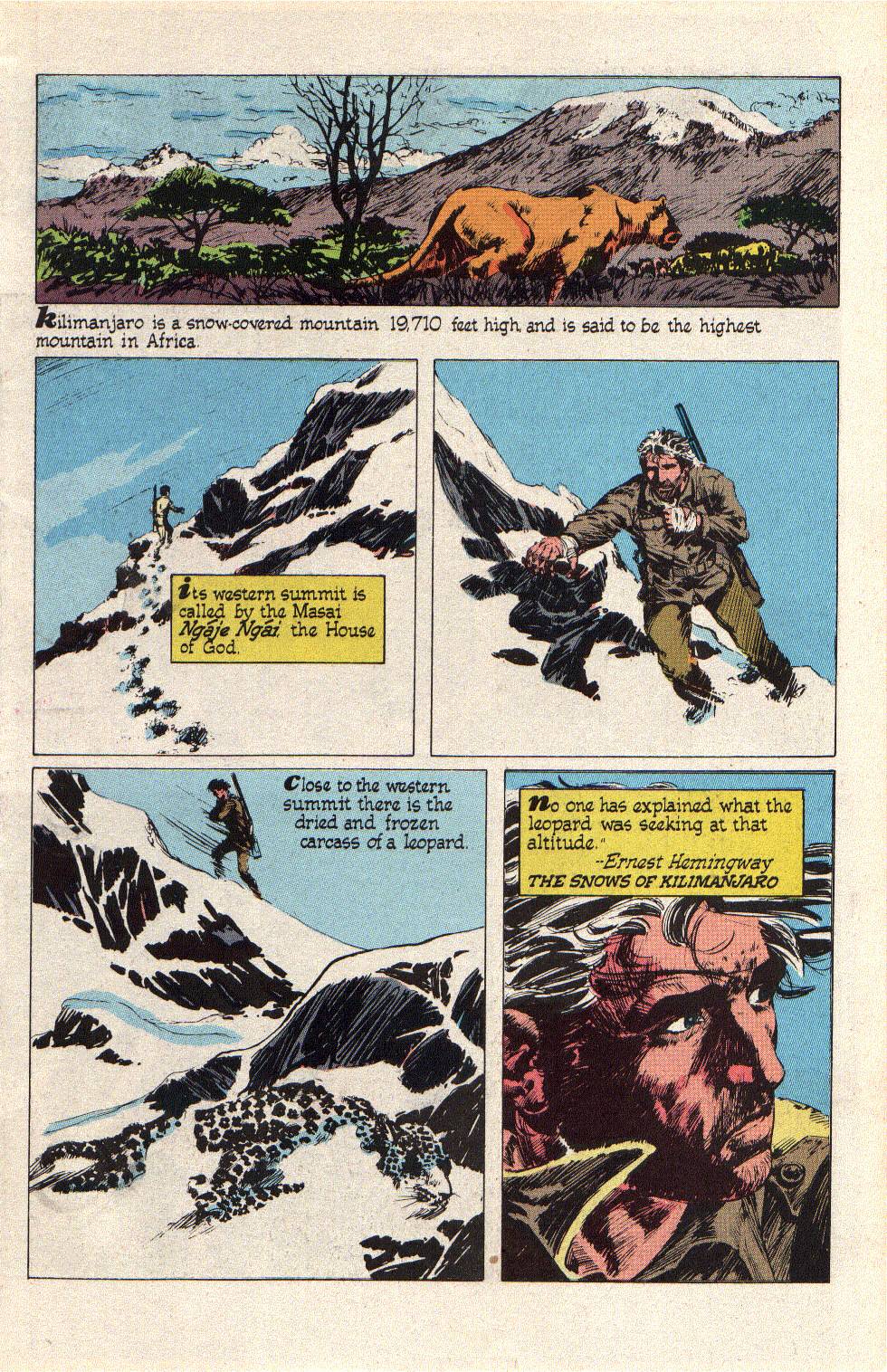 Jon is back in Africa, and he is being hunted. he stops at a watering hole and drinks his fill, across from giraffes and other animals, then they and he take to the bush, on a run. We then see men with AK-47s and a tracker, who examines the spoor near the waterhole. Grell juxtaposes images of a pack of hyenas bringing down a gnu (wildebeast) with the men hunting Sable... 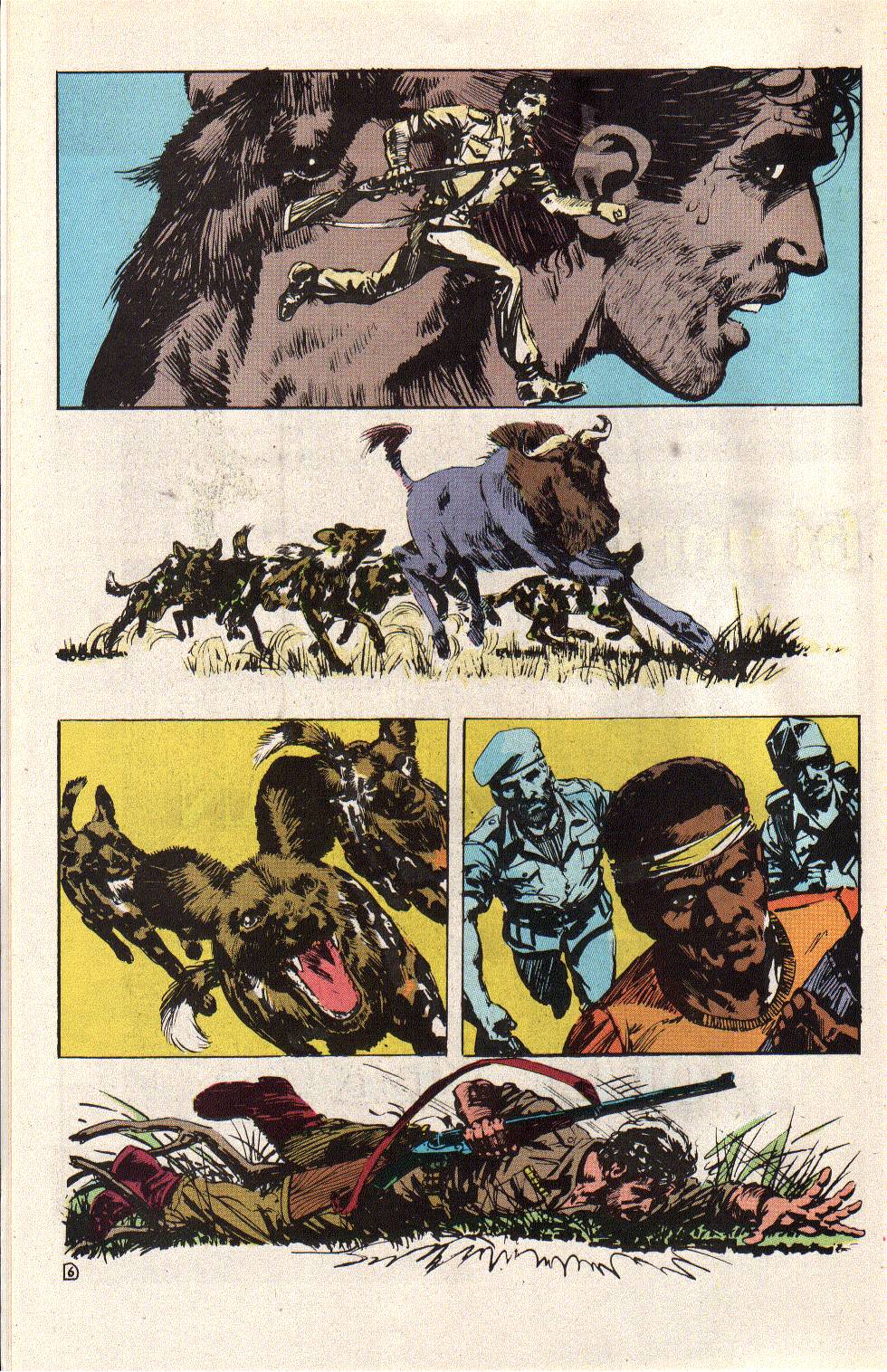 Jon trips over some brush and gets up, seeing the hyenas bring the gnu down and attack it, savagely, with its numbers. Jon runs on and nearly collides with a snake (possible a black mamba) and blocks its striking head with his rifle barrel and chops off its head with his bush knife. he takes the body of the snake, leaving the head behind. Later, he takes shelter behind a rock formation and cuts open the snake's carcass and eats the meat, raw. he sleeps in a crouch, dreaming of his wife and children and their burning home. he awakens to find a small group of deer/antelope grazing (not sure of the species). He breaks open his rifle and we see he has one cartridge in the twin barrels and no ammo in the loops of his shirt or his belt. he moves on. Eventually, he comes to a ranch home and we see an older couple on a veranda. the man has a white military mustache and the couple see him in the distance, walking towards the house.... 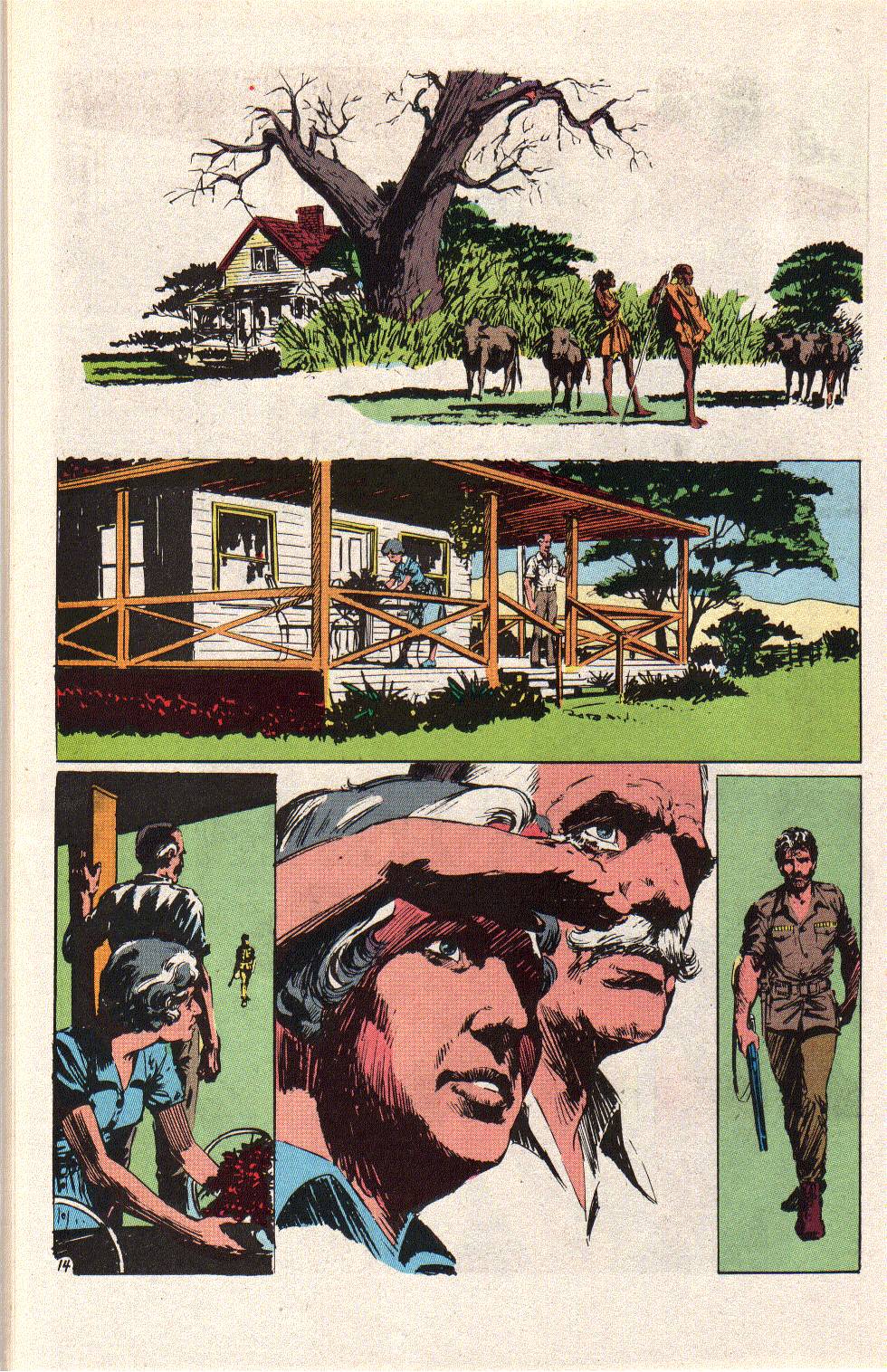 Jon says hello to Col. McKenna, Elise's father and her mother, Ruth. He tells him to go away, that he has brought enough death on their house and that every bounty hunter in Africa is looking for him. he berates him for leaving a trail that a blind man could follow, right to their home. Jon just answers he had nowhere else to go. he says he won't stay, but asks for any ammunition they might have for his rifle and any .45 for his mauser, which has been empty for a week. Col McKenna says he has chosen Death for a mistress. Jon fires back that the colonel was a soldier and asks about Dunkirk and Tobruk. He says the colonel once said the dawn never smelled as sweet when you thought you'd never see another one. McKenna rebuts and walks away. Jon tells Ruth that the colonel thinks Jon killed Elise and she stops him, telling him to never think that. He knows how much Jon loved Elise and he loved the children, but Elise was special to him. he missed the childhoods of their other children, in the service, but Elise came along later and she was special to him. She followed him everywhere, carrying a stick to imitate how he carried a rifle. 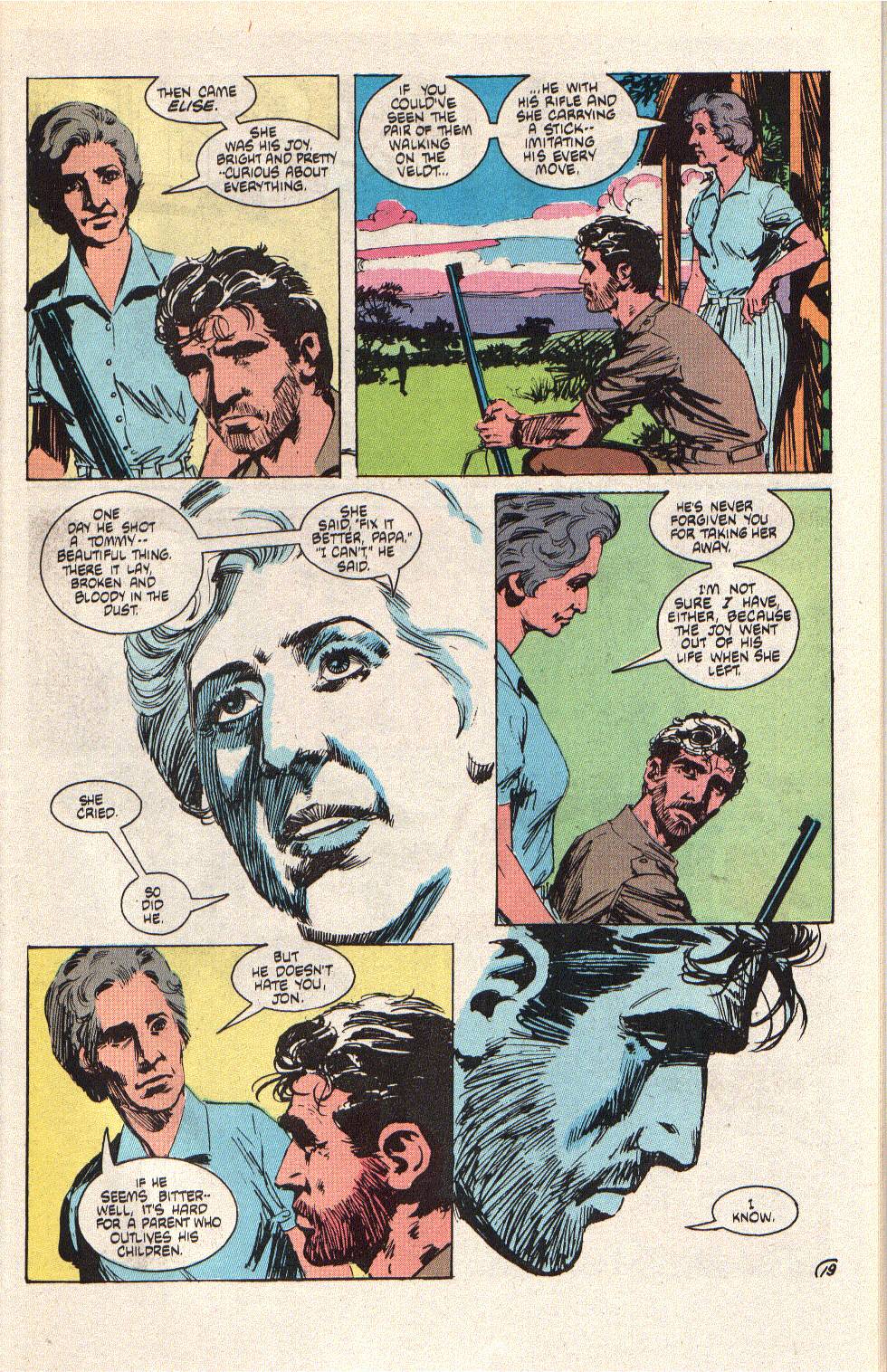 They go into the house and Ruth goes to get spare ammo for Jon. He speaks of trying to get to Johannesburg, but people were waiting for him. the price on his head was never rescinded. he doesn't fault them, saying they do what they must to survive. Ruth asks if that is what he does, survive and asks of the hopes and dreams he had. he says they died with Elise and the kids. She says then why go on, why run? She says she thought Jon was courting death, before, when he was with the mercenaries, but something has changed and she asks if he has found something to live for? Jon then tells her about the stories he writes.... 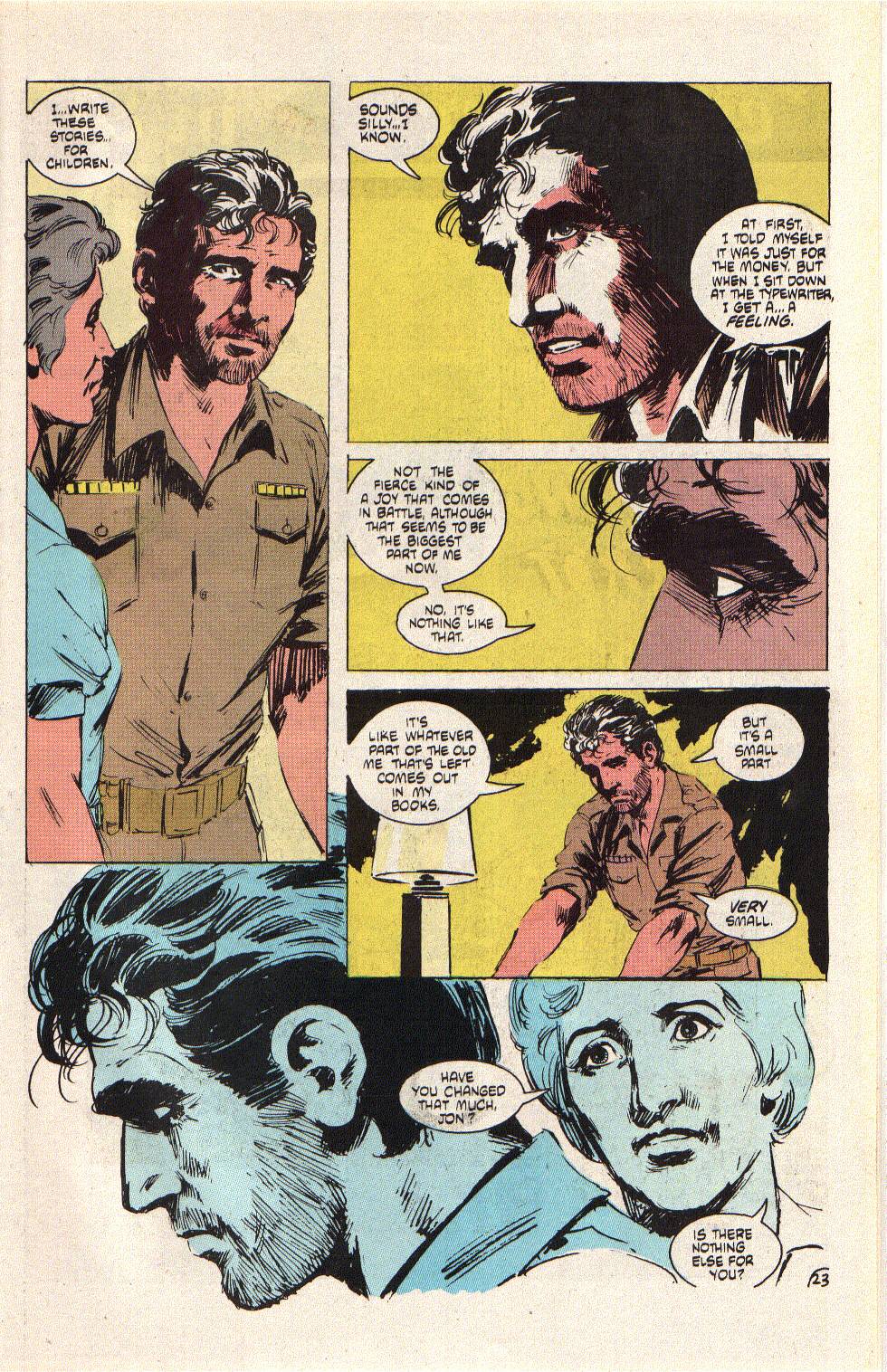 Ruth asks if there is nothing more and Jon answers.... 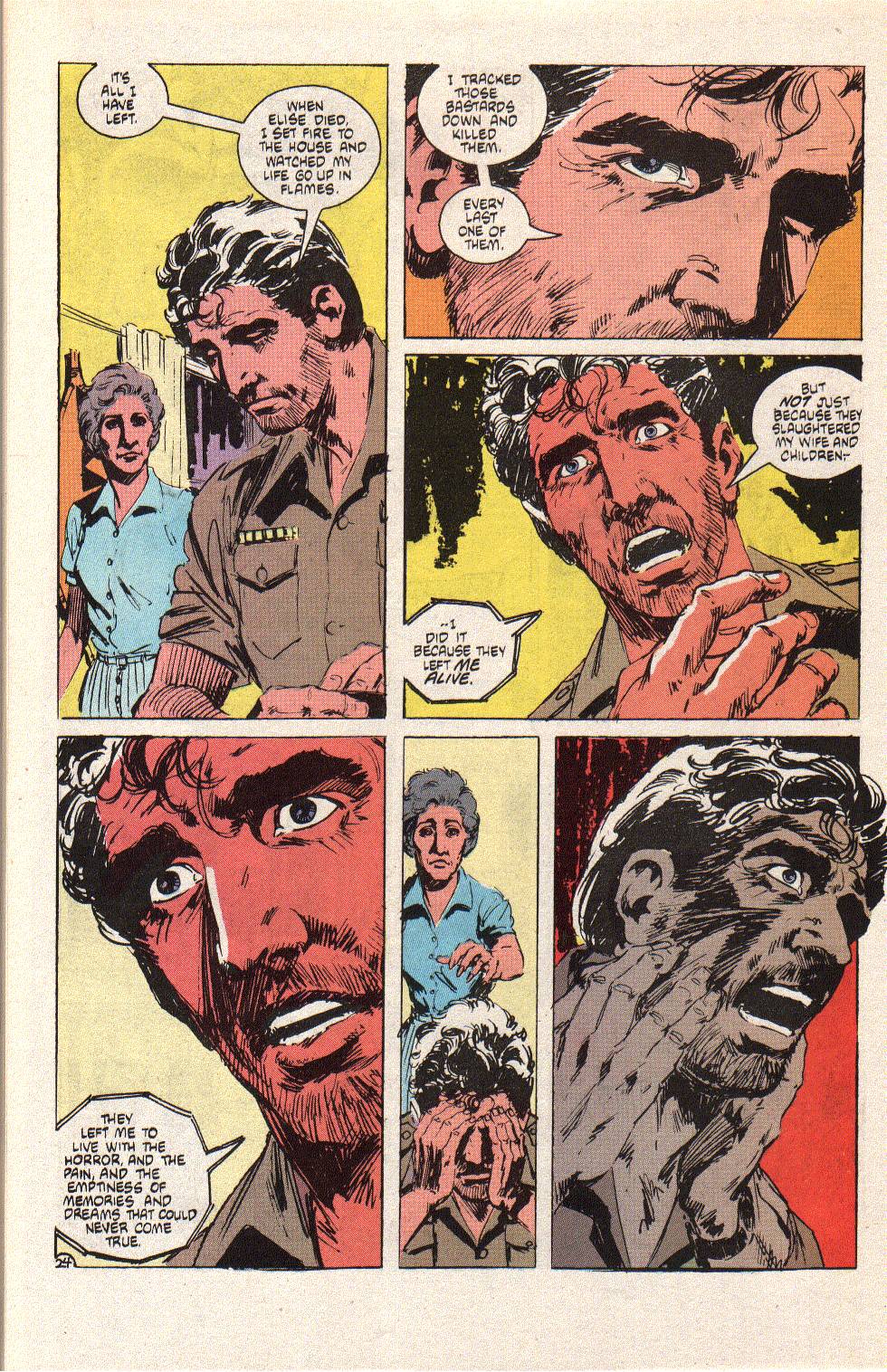 The colonel has returned and he heard what Jon had said about being left alive, with the memories and the pain. Jon sees him and stares at him for a moment, then grabs his rifle and says he will be moving on. he leaves the house, without taking the ammo. Col McKenna sees the boxes next to a picture of Elise, on a mantle. He stares at the photo and there is a tear in his eye. His picks up the phot and sits down and stares at it, thinking of his daughter and how she died and the man she left behind. We see guns blazing, then a single shot from a double-barrel .375 Holland & Holland. The colonel puts the picture back, takes the boxes of ammo and a Sten Mk6 submachine gun and heads out into the veldt. Thoughts: A powerful issue, purely a character study. We finally meet Elise's family, her father Col Nicholas Mckenna, formerly of the Royal Army. Her mother Ruth, a strong woman who raised the family while she waited for her husband to come back from duty. They lived in Africa and he got to experience his daughter's childhood and the wonder of Africa, through her eyes. He got to experience the joys of grandchildren and then it was taken away in thunder. The man who took her away from him is still alive, but seems determined to die in some violent manner and he projects his own grief onto Jon. When I originally read this, decades ago, I was confused as to whether this was a flashback to the time when he hunted the poachers or was the present, until Jon talks to Ruth about his books. It seemed odd that there was still a bounty on his head, with Pyke dead. Of course, there was still the mysterious telegram that Jon found, when he killed Pyke, in Salisbury, from J. We still don't know who J was/is and maybe they have a long memory. Why Jon is there, seems obvious. He settled with the poachers; but, his family rests in Africa. You honor your loved ones by visiting their graves. Nothing, not even a bounty, is going to stop jon from visiting his family's graves. The art is a bit sketchier than before (probably deadline constraints), but, Grell excels at the wildlife and the scenery and it feels like Africa, even if you have never been there (and I haven't); or, at least, what you think it feels like. He captures the beauty of the veldt, the highlands, the animals, the unspoiled land, then he throws in the predators. the title of this issue referred to Jon, as he is the hunted, in this. For Jon, this is about family, about why hoe goes on and about who Elise was. Jon still isn't telling the whole story, as I see it. he says the books connect him to the man he was. I think it connects him to the children he lost and their delight in his stories is mirrored in the children who love them now. He doesn't admit his growing feelings for Myke and doesn't mention her. I suspect that is because he doesn't want to bring up the possibility of someone else, after Elise, especially to her mother; but, I think he does her a disservice, as she would want him to live. She speaks of his hopes and dreams, knowing that you can still have those things, even when you have lost the ones with whom you wanted to share those hopes and dreams. Jon just can't see that, yet. besides, he still has not had even a dinner with Myke, who has flat out told him he scares her. he is haunted by Elise and I think he is scared of loving someone else, deeply, rather than just a loose relationship and a bit of sex, to keep going. I think he is scared of loving Myke as much as she is scared of loving him and losing him in violence. We aren't there yet, but Grell is far from done with Jon and Myke, not to mention Africa (though we do not see the Mckennas again). This is another favorite, because, like "A Storm over Eden," it gets to the heart of who Jon is, and it is deeper than scarred child who trains himself to become a vigilante or last survivor of a doomed world, as great as those characters are (and as deeper they became, with the passage of time). Jon is a "real" human being, with virtues and vices, strengths and failings, hopes and fears. He's not some Mickey Spillane tough guy, gulping down whiskey and shooting vermin. He is not James Bond, living the high life while he "slays dragons for Queen & Country." He is a man whose family was torn away in violence, who descended into madness to avenge them and came out the other side. he dances along the edge between the madness and a new life and that is what made him such a great character, especially in 1984. Grell showed us that comic book adventure heroes could have the depths of their literary counterparts and still be as exciting as the Long Underwear Brigade. If I do have a criticism, it's a minor one: it seems odd that Col. McKenna would stock ammo for both a .375 H&H and a .45 cal pistol. I might buy the rifle, if he used a similar model hunting rifle. They .45 seems a stretch, when 9mm is more common in Africa and the British Army. Jon even remarks that his stalkers tend more to 9mm and wonder if he should swap barrels (which caliber conversion takes more than just slapping on a new barrel; but, whatever). The weapon he grabs to go after Jon is a 9mm submachine gun, from WW2. If he still had his service revolver, it would have more likely been a .455 Webley, which isn't exactly the same as a .45 ACP. Some men did carry the Browning Hi-Power 9mm (called the Pistol No II, Mk I) and some did have .45 ACP, though mostly in the special forces, like the Commandos or the SAS (rechambered for the .455). Like I said, minor, and certainly open to debate, as we don't know what regiment the colonel served with, though if he was at Tobruk, Dunkirk and Normandy, that narrows it a bit. Likely not a special forces unit, though. We'll just assume he liked the Yank .45. Next issue, Jon faces death from a different quarter, in an urban jungle. This one is also a bit of a character piece.
|
|
|
|
Post by foxley on Oct 5, 2021 1:57:22 GMT -5
Putting my English major hat on, I suspect there may be a simpler explanation of the 'Henry' reference. The central character of Hemingway's A Farewell to Arms is Frederic Henry. Like all of Hemingway's writing, the novel is strongly autobiographical: based on Hemingway's experience as an ambulance driver in the Italian campaign of WWI. My guess would be that 'Henry' was Iron Mike making a tip of the hat to Hemingway for the quote from The Snows of Kilimanjaro. But I could be wrong. I often am.  As side note, I suspect Hemingway may have picked the name Henry for his hero because of his fascination with the author Henry James. |
|
|
|
Post by tartanphantom on Oct 5, 2021 8:12:24 GMT -5
ps Forgot to mention; I know I have seen the Wyeth painting before, but Google didn't help me locate it or the specific title and source. It looks a bit more like Andrew Wyeth's style, but, this is Grell's interpretation, so it could be NC Wyeth, as it fits the kinds of subjects he illustrated, for books and magazine stories. Anyone who can identify it, please shout out. I used to have a few books of NC Wyeth's art, but gave them up in a move. Most of them focused on the work he did for the Scribbners books (like his Treasure Island illustrations) and some of his more notable paintings and illustrations. I did not have much reference for Andrew, since NC did more of the storytelling art, which is more my interest.
The Wyeth painting is a pretty obscure one. It was painted by N.C. Wyeth around 1906-07 as part of a series of magazine ads for Cream of Wheat.
The painting is simply entitled: "Yukon Freighter", although is is sometimes mis-titled as "Alaska" (second illustration), due to its inclusion on a series of trade cards issued by Cream of Wheat.
|
|
|
|
Post by codystarbuck on Oct 5, 2021 11:15:41 GMT -5
ps Forgot to mention; I know I have seen the Wyeth painting before, but Google didn't help me locate it or the specific title and source. It looks a bit more like Andrew Wyeth's style, but, this is Grell's interpretation, so it could be NC Wyeth, as it fits the kinds of subjects he illustrated, for books and magazine stories. Anyone who can identify it, please shout out. I used to have a few books of NC Wyeth's art, but gave them up in a move. Most of them focused on the work he did for the Scribbners books (like his Treasure Island illustrations) and some of his more notable paintings and illustrations. I did not have much reference for Andrew, since NC did more of the storytelling art, which is more my interest.
The Wyeth painting is a pretty obscure one. It was painted by N.C. Wyeth around 1906-07 as part of a series of magazine ads for Cream of Wheat.
The painting is simply entitled: "Yukon Freighter", although is is sometimes mis-titled as "Alaska" (second illustration), due to its inclusion on a series of trade cards issued by Cream of Wheat.
Thank you! I searched the internet for over an hour and the books I had did really cover his commercial art. |
|
|
|
Post by foxley on Oct 5, 2021 15:13:15 GMT -5
Putting my English major hat on, I suspect there may be a simpler explanation of the 'Henry' reference. The central character of Hemingway's A Farewell to Arms is Frederic Henry. Like all of Hemingway's writing, the novel is strongly autobiographical: based on Hemingway's experience as an ambulance driver in the Italian campaign of WWI. My guess would be that 'Henry' was Iron Mike making a tip of the hat to Hemingway for the quote from The Snows of Kilimanjaro. But I could be wrong. I often am.  As side note, I suspect Hemingway may have picked the name Henry for his hero because of his fascination with the author Henry James. And now I reread my own post, perhaps it's Henry James Mike is crediting for the dialogue. Hmm.... |
|


















